Urban Architecture in Pompeii
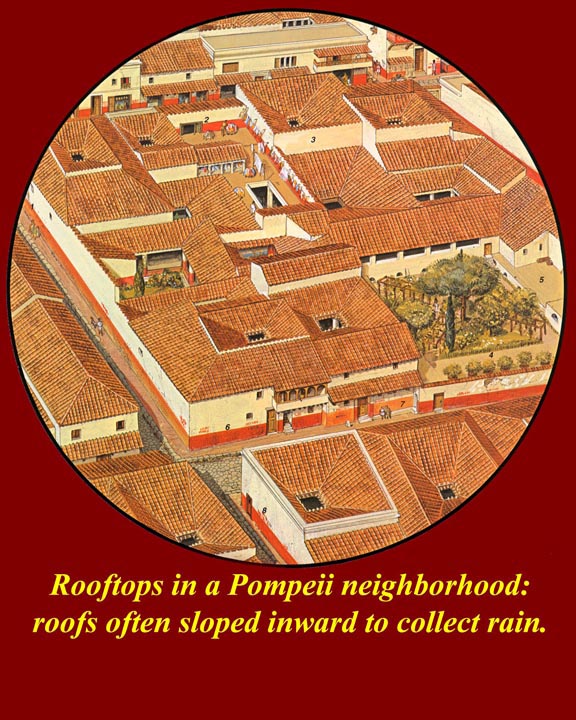
http://www.mmdtkw.org/ALRIVes0701PompeiiRooftops.jpg
The simulated rooftops of a single insula (= "island" = city block) in Pompeii. Many roofs slope inward for rainwater collection.
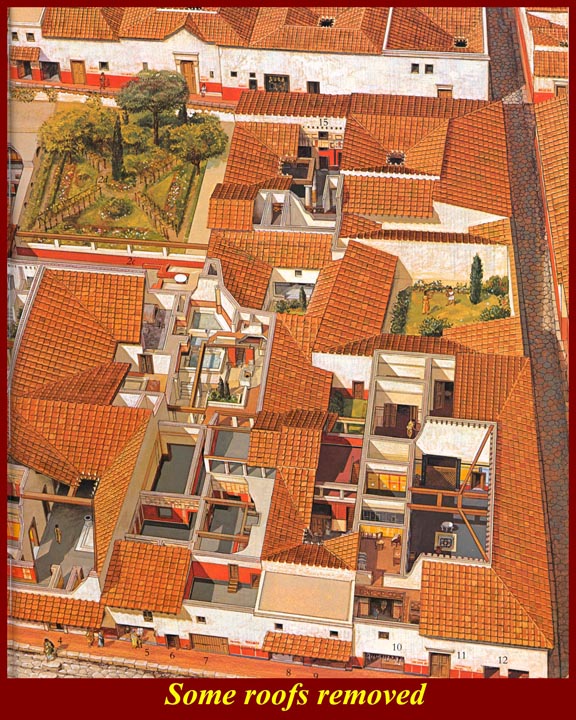
http://www.mmdtkw.org/ALRIVes0702SomeRoofsRemoved.jpg
The same block with some roofs removed to show rooms inside the structures.
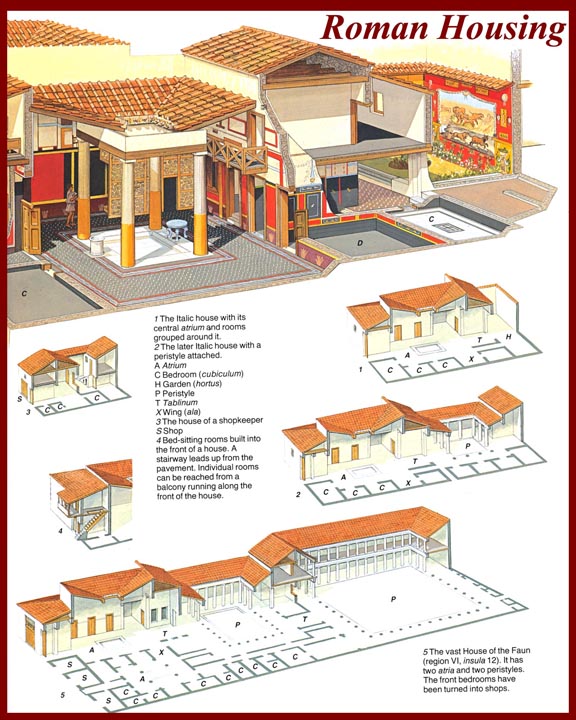
http://www.mmdtkw.org/ALRIVes0703RomanHousing.jpg
A cutaway side view of one of the houses and development of the Pompeian domus.
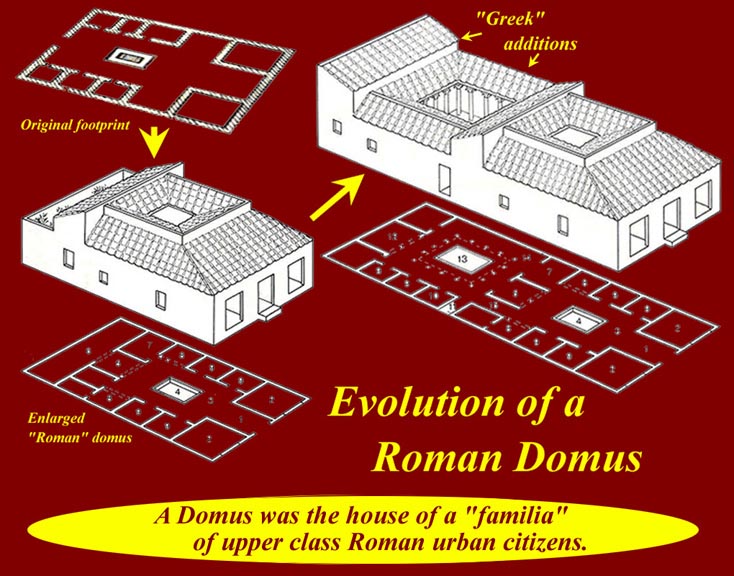
http://www.mmdtkw.org/ALRIVes0704DomusEvolves.jpg
More on the development of the domus.
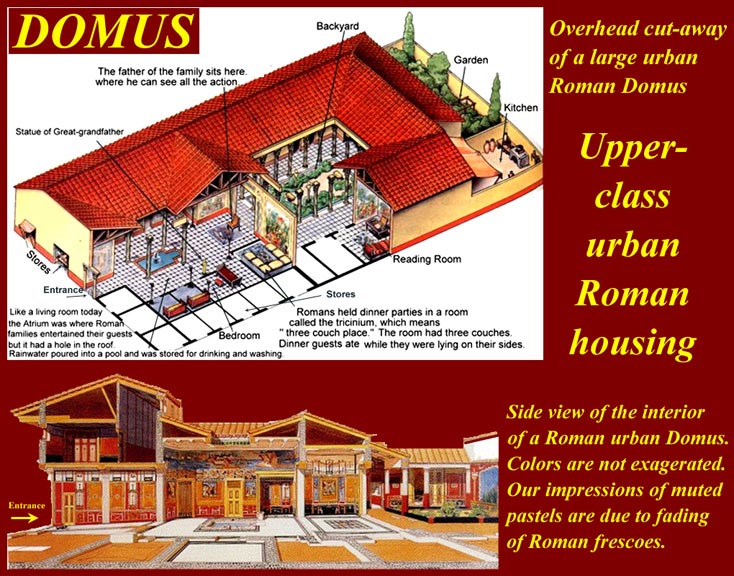
http://www.mmdtkw.org/ALRIVes0705Romanhouse.jpg
The interior of a large domus.
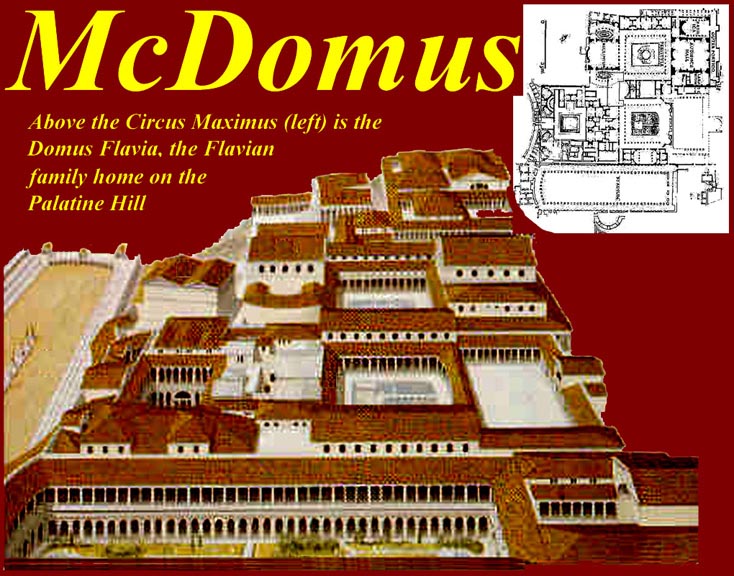
http://www.mmdtkw.org/ALRIVes0706DomFlavia.jpg
How big can a domus get? This one is the Imperial Palace in Rome.
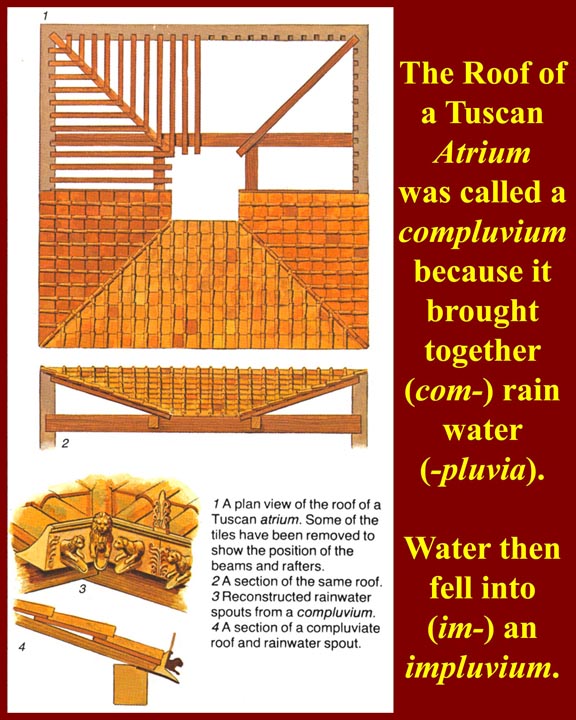
http://www.mmdtkw.org/ALRIVes0707Compluvium.jpg
An impluvium is a roof structure that directs rainwater (pluvia) inward (im). Water was collected below in a small pool called a compluvium. Overflow from the compluvium was directed to an underground cistern.
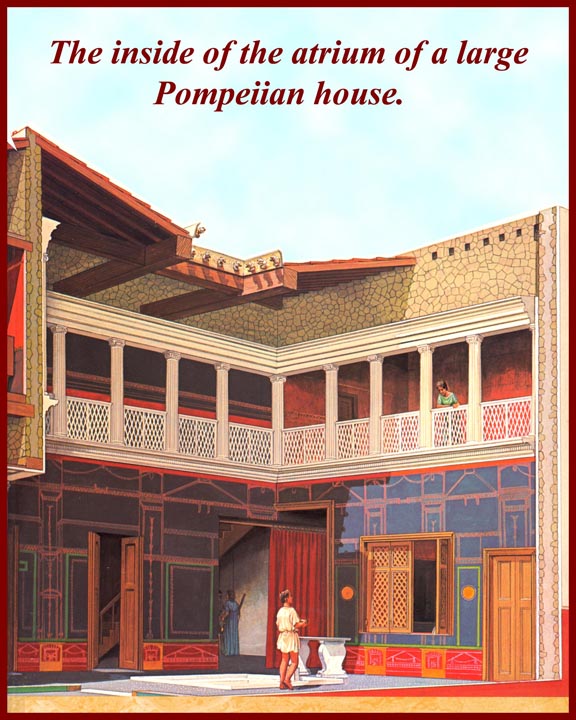
http://www.mmdtkw.org/ALRIVes0708PompeiianAtrium.jpg
The atrium appears to have been developed by the Tuscans (i.e., Etruscans) and the Oscans. An Etruscan atrium often had a gallery with doorways into second floor rooms. Oscan Atria might have a simulated gallery.
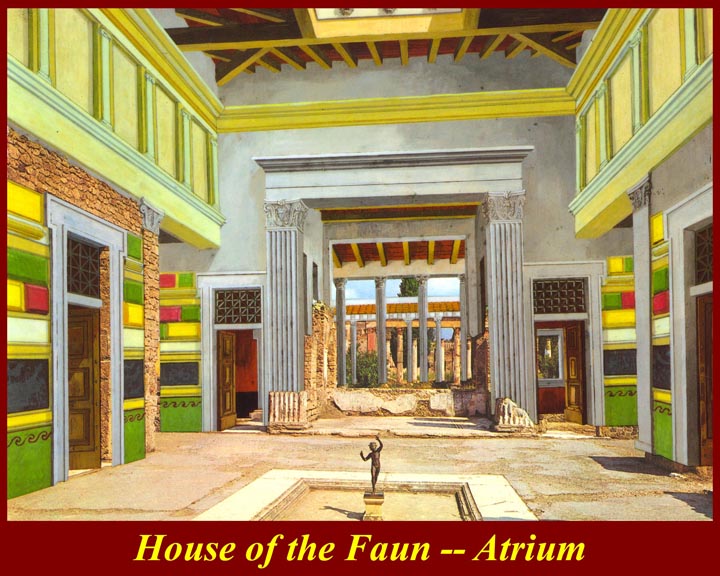
http://www.mmdtkw.org/ALRIVes0709FawnHouse.jpg
An Oscan atrium -- house of the faun.
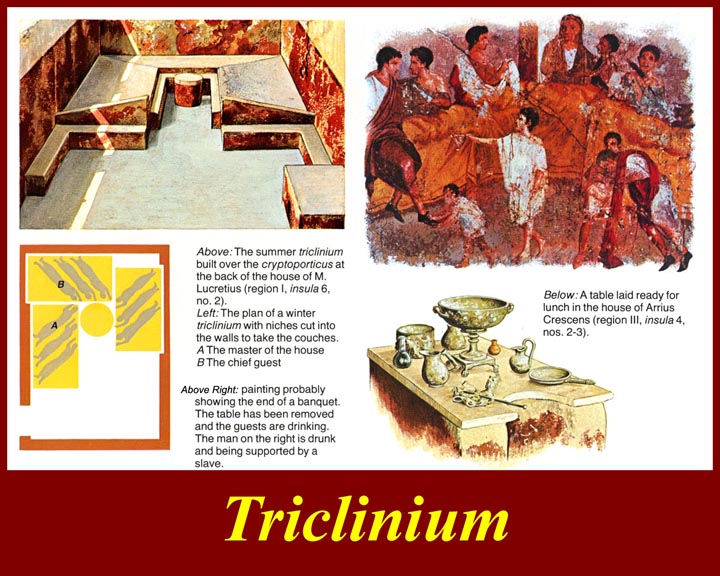
http://www.mmdtkw.org/ALRIVes0710Triclinium.jpg
Upper class formal dining was usually in a triclinium, a room or area with three couches or benches where people reclined to eat. Later, after the destruction of Pompeii, there were also semi-circular arrangements called stibadia, but the triclinium remained the norm throughout the ancient Roman period. There were summer triclinia -- ourdoors -- and indoor winter triclinia. Most eating was less formal. Poor folks apparently ate at tables of counters and sat on backless chairs or benches.
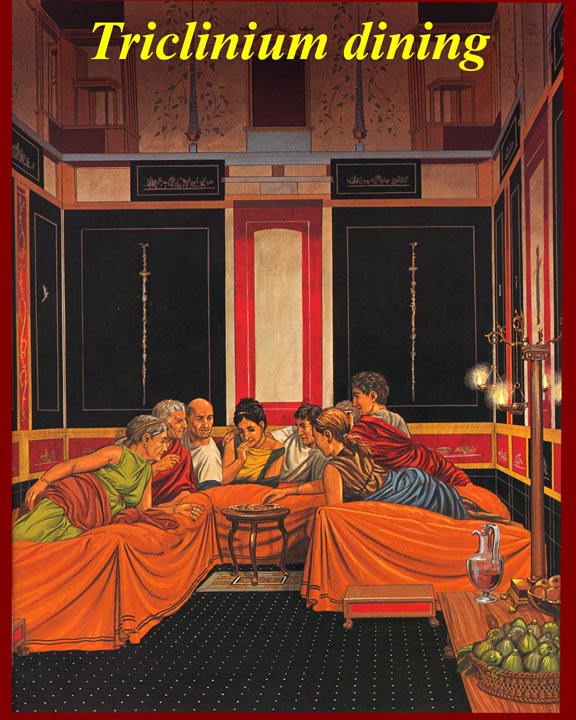
http://www.mmdtkw.org/ALRIVes0711TricliniumDining.jpg
A triclinium scene.
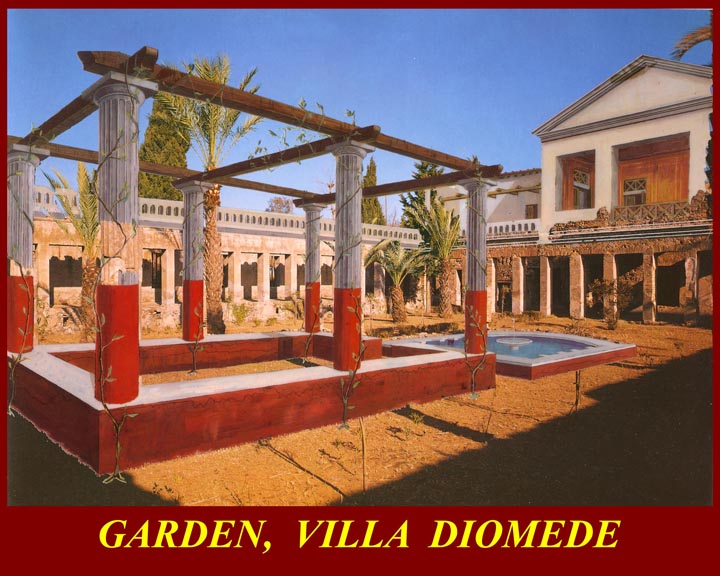
http://www.mmdtkw.org/ALRIVes0712GardenVDiomede.jpg
If you were rich enough, your house would have an enclosed garden -- a viridarium.
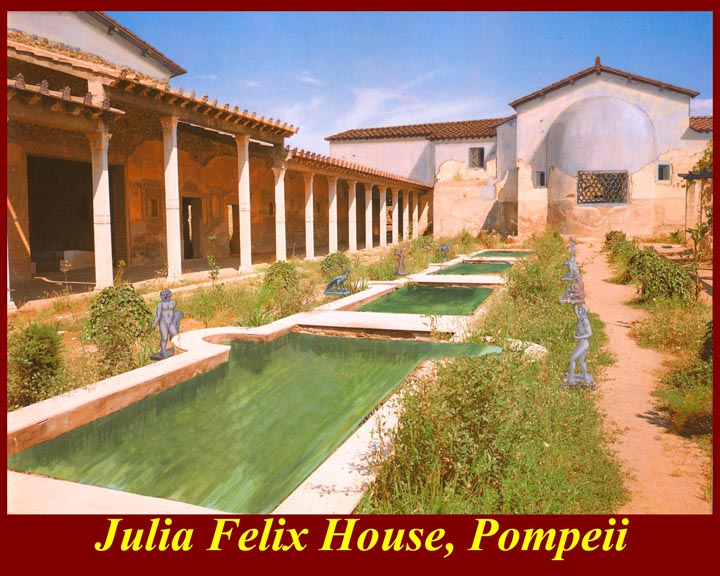
http://www.mmdtkw.org/ALRIVes0713JuliaFelixHouse.jpg
The bigger, the better. Big water features were sure signs of wealth.
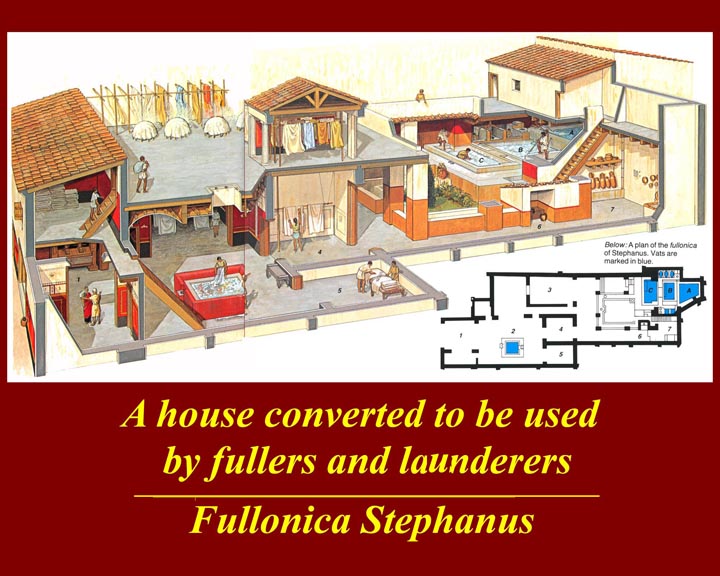
http://www.mmdtkw.org/ALRIVes0715FullonicaStephanus.jpg
Pompeii lasted for centuries, so there, naturally, were changes in use. The Fullonica Stephanus was a laundry that had previously been a large domus.
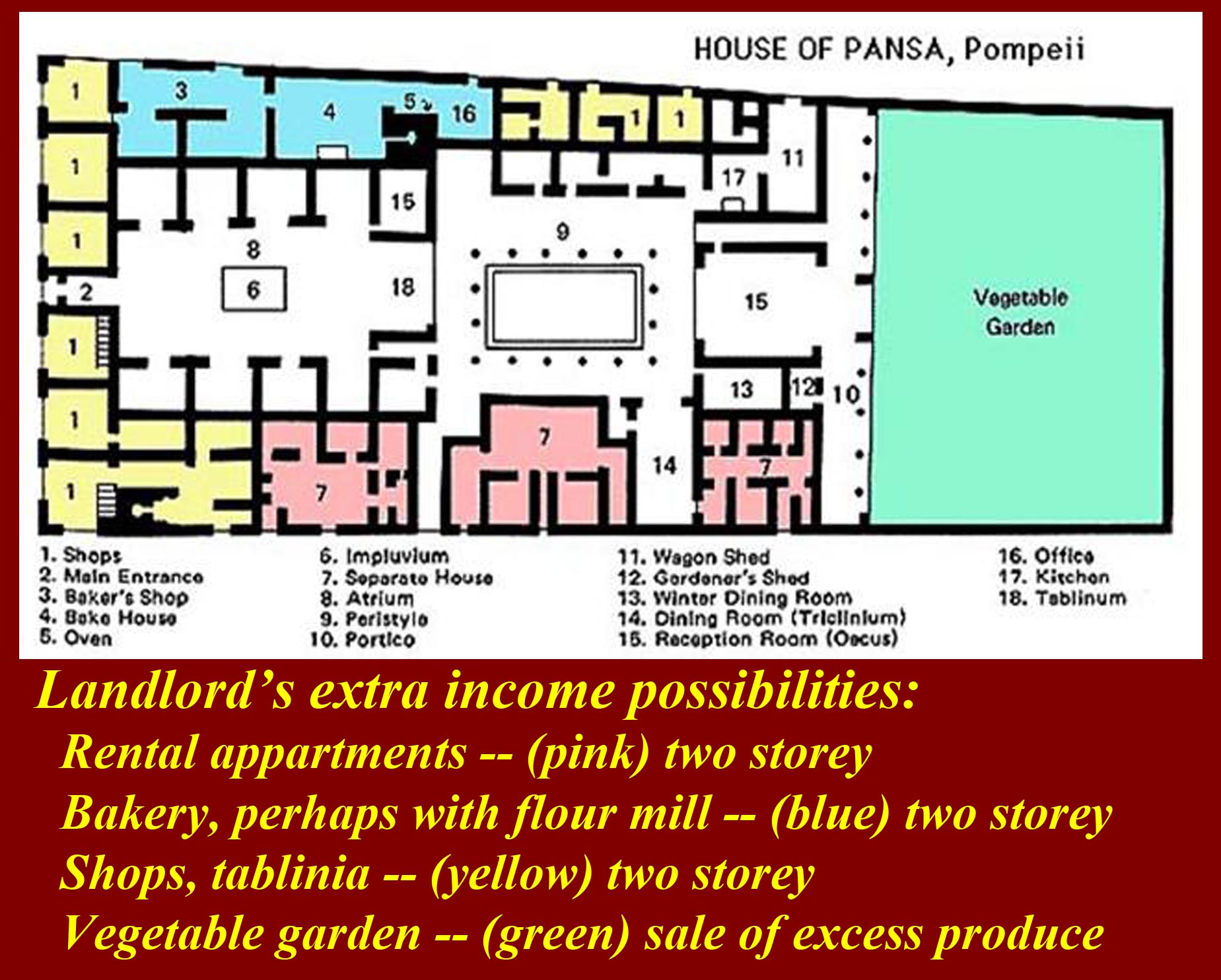
http://www.mmdtkw.org/ALRIVes0715xLandlordIncome.jpg
Besides turning your domus into an industrial venue, like a fulonica, you could use the street-side areas as shops, restaurants, bakeries , or manufactories. These could be operated by yourself, or members of your familia, or non-familia renters. The back garden might produce fruit and vegetables for home use or for saje. A back yard water feature could produce fish for the table.
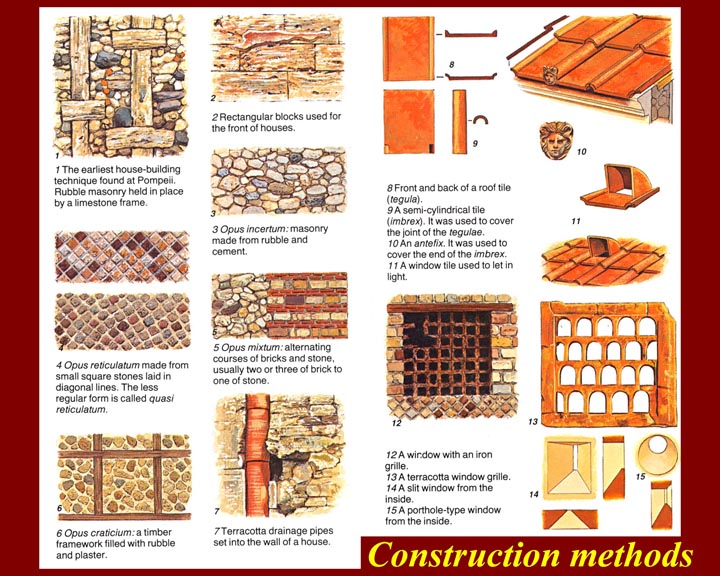
http://www.mmdtkw.org/ALRIVes0714ConstructionMethods.jpg
Building and construction methods varied considerably. There was a lot of opus mixtum which could mean alternating layers of it could mean "mixed work" caused by numerous bouts of remodeling and expansion.
City water, drains, and sewers:
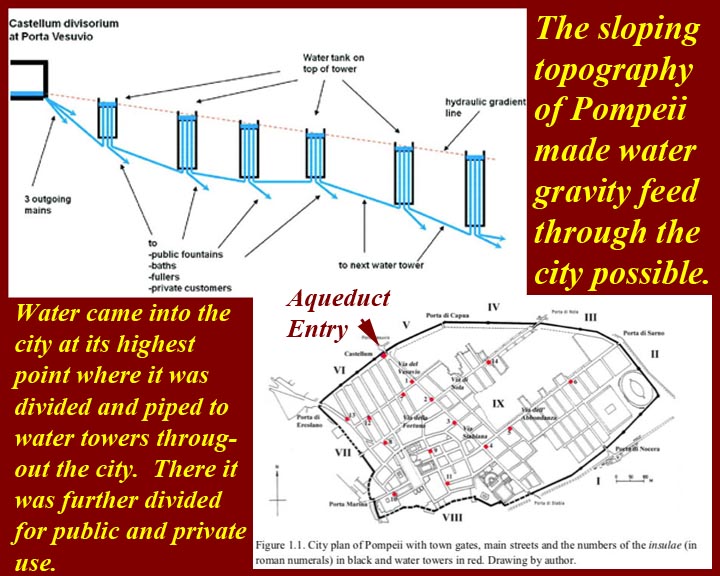
http://www.mmdtkw.org/ALRIVes0714tPompeiiWater.jpg
The Roman General Sulla suppressed Pompeii's revolt in 80 BC. In the following "Roman years" of Pompeii a great expansion of the water supp[y around the Bay of Naples was needed to supplement rain water catchment and groundwater wells within the towns and cities (22 wells identified in Pompeii). Early in the reign of Augustus (28 BC - 14AD) Pompeii, Heculanum, and othe Bay of Naples localities were connected to a new aqueduct, the Aqua Agusta, one of the largest, most complex, and costliest aqueduct systems in the Roman World. Unlike any other of its time, it was a regional network rather than being designed to serve one urban center. Before the earthquakes of the early 60s AD, it could supply 4000 cubic meters per day to Pompeii, and by the time of the 79 AD earthquake repairs had progressed to the point that it could supply 2000 cubic meters. Water from the Aqua Augusta entered the city at its higher northern edge through a Castellum Aquae Divisorum at the city's Vesuvius Gate.
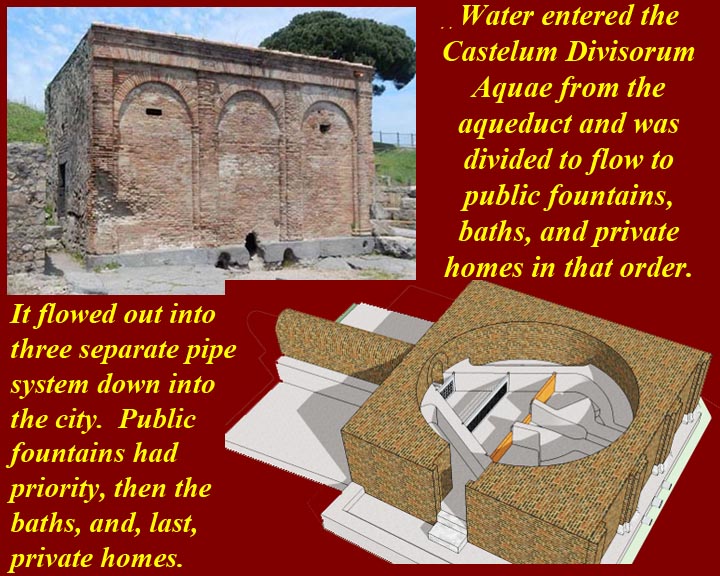
http://www.mmdtkw.org/ALRIVes0714uCastelumAquao.jpg
The Castellum divided the water into three streams: for public use (free flowing taps at many city intersections), for the city baths, and for connections to private premises. In times of shortage, water might be limited or shut off first to the private users, then to the baths. The idea was to keep the public spigots flowing as long as possible.
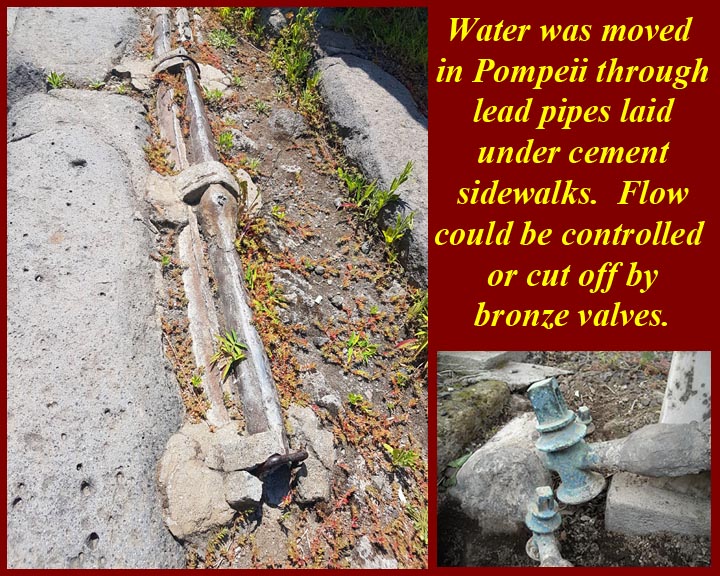
http://www.mmdtkw.org/ALRIVes0714vLadPipeSidewalk.jpg
Water moved through the city through lead pipes and could be controlled by bronze valves. Contrary to what has been been proposed, lead poisoning was unlikely to have resulted from use of lead water pipes and receptacles in Roman water systems -- Italian hard water quickly left calcium deposits that prevented lead from leaching into water supplies. On the other hand, lead pipes and tanks used in the wine industry could easily degrade and introduce lead into wines.
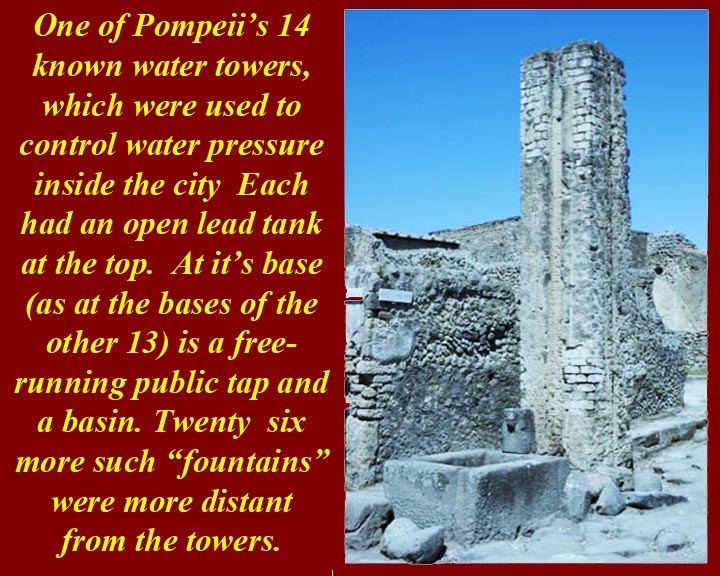
http://www.mmdtkw.org/ALRIVes0714wWaterTower-Fountain.jpg
One of Pompeii 14 known water towers that were used to regulate water pressure inside the city. Lead pipe ran through groves in the structure to fill and drain an open lead tank at the top of each tower. The exact route of water flow among the towers is not known. Similar methods of water flow contro are still used today in areas with differing elevations.
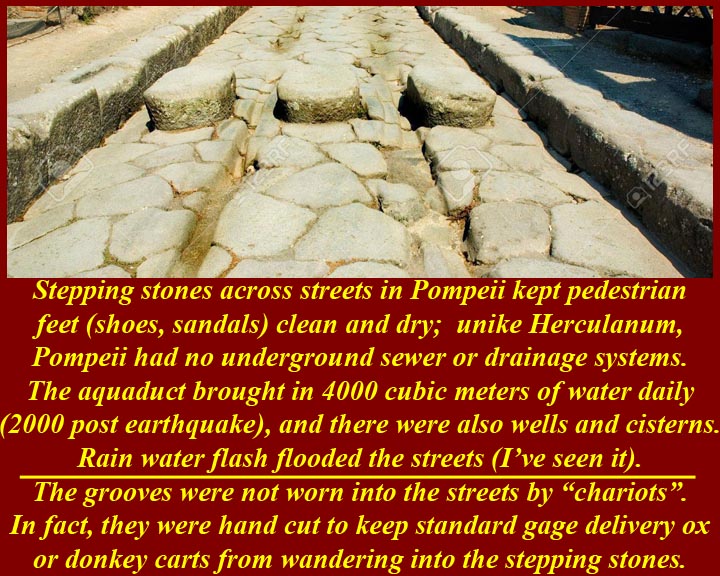
http://www.mmdtkw.org/ALRIVes0714yPompeiiStreetSewers.jpg
Pompeii's streets were its sewers. Stepping stones like these (hopefully) kept footwear clean and dry. Streets in ruined Pompeii still flash-flood during rain storms. The ruts were hand carved int the streets to keep standard guage ox and donkey carts from breaking wheels and axles on stepping stones.
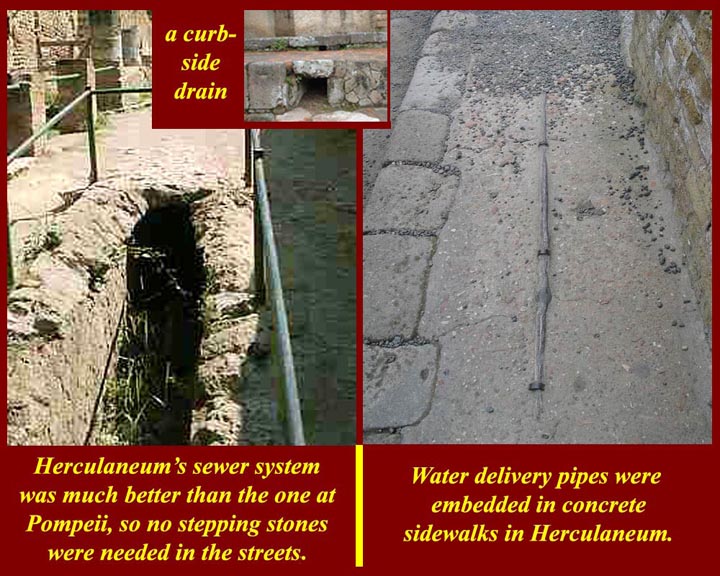
http://www.mmdtkw.org/ALRIVes0714xWaterSewer.jpg
Herculanum (or at least the parts that we know) did have a sewer and drainage system. I just may have been easier to dig sewers in herculanum.
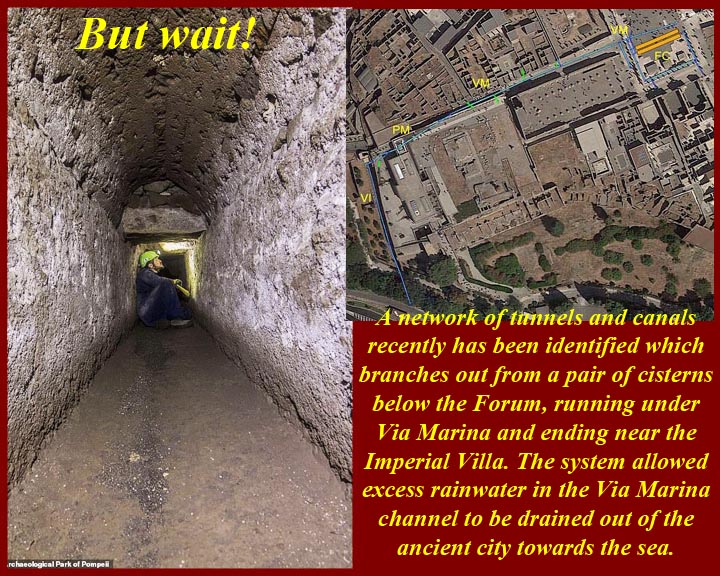
http://www.mmdtkw.org/ALRIVes0714zPompeiiDrainage.jpg
There was some provision to keep the forum area from flooding during rain storms. A pair of catchment cisterns at the southern (downhil) end of the forum drained through water tunnels toward the sea. Tunnels in the same system also apparently connected some temples in the forum area as well as the forum baths. The Pompeii Archeological Park authorities hope to clear and reuse the cistern/tunnel network.
City walls, towers, gates
http://www.mmdtkw.org/ALRIVes0719uPompeiiWalls1.JPG
The circuit of Pompeii walls was greatly expanded to the norh and even more so to the east after General Sulla's conquest of the city in 89 BC. It took years to fill up the new walled areas, but by 79 AD that had been done, and suburbs had sprouted up outside the walls. In some areas, houses, baths, and other structures were even built on and over the no walls which were no longer needed for defense.
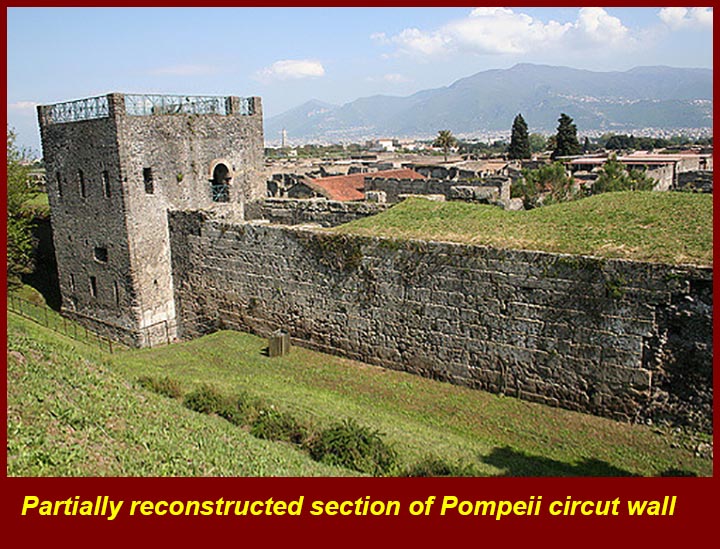
http://www.mmdtkw.org/ALRIVes0719vPompeiiWalls2.jpg
A partially restored section of Pompeii's wall and one of Pompeii' wall towers.
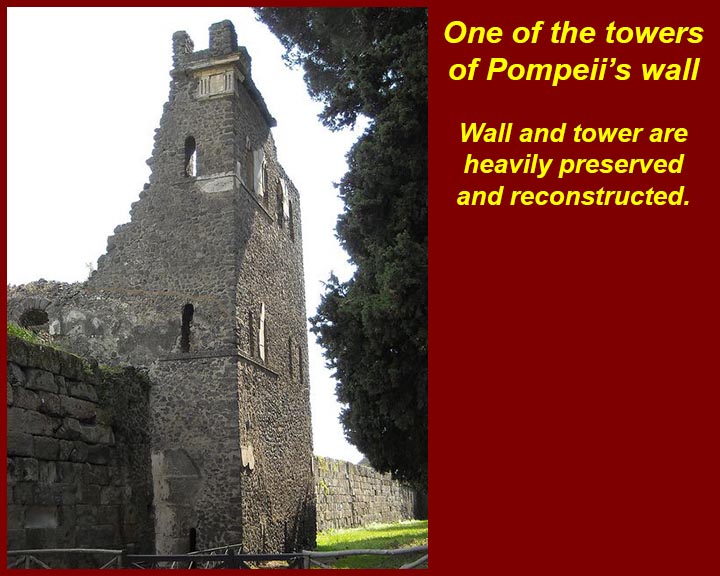
http://www.mmdtkw.org/ALRIVes0719wPompeiiWalls3.jpg
Anothe Pompeii wall tower.
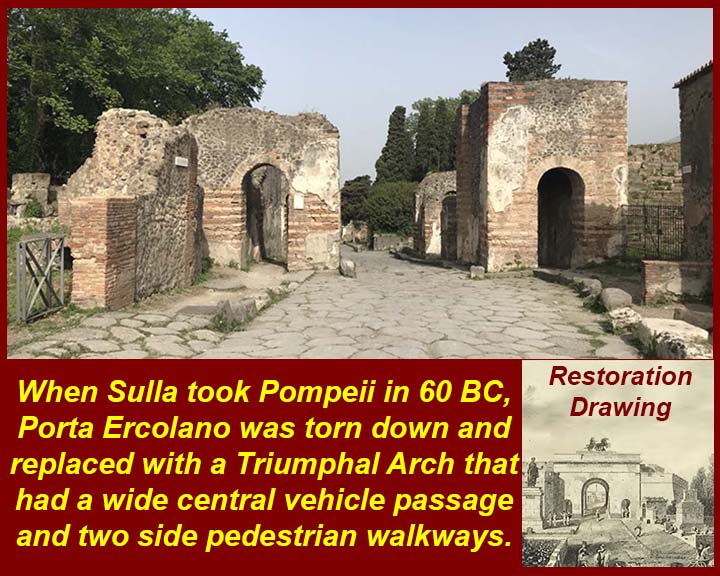
http://www.mmdtkw.org/ALRIVes0719xPortaErcolano.jpg
Porto Ercolano -- the old gate through Pompeii's wall on the road connecting the city to Herculanum was torn down by Sulla's military Pompeii colonists and was replace by a three portal Triumphal Arch type gate with a central wide gate for wagons and two side pedestrian entrances. The central arch was knocked down by the 79 AD eruption.
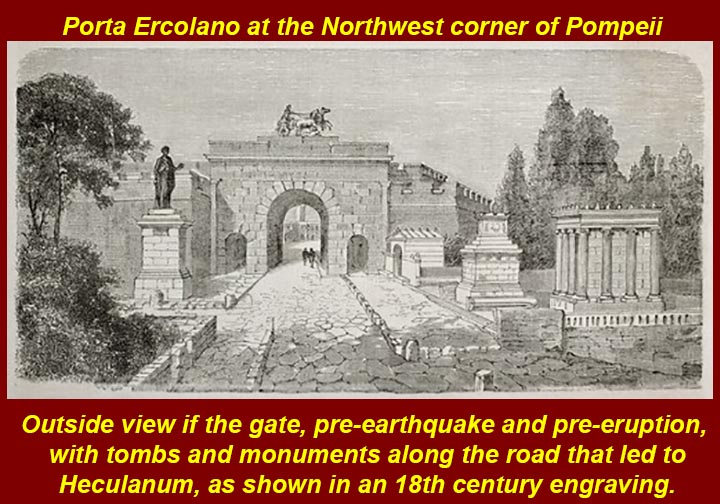
http://www.mmdtkw.org/ALRIVes0719xxPortoErcolanoRest.jpg
Outside view of Porto Ercolano and roadside tombs/monuments as envisioned in an 18th century engraving.
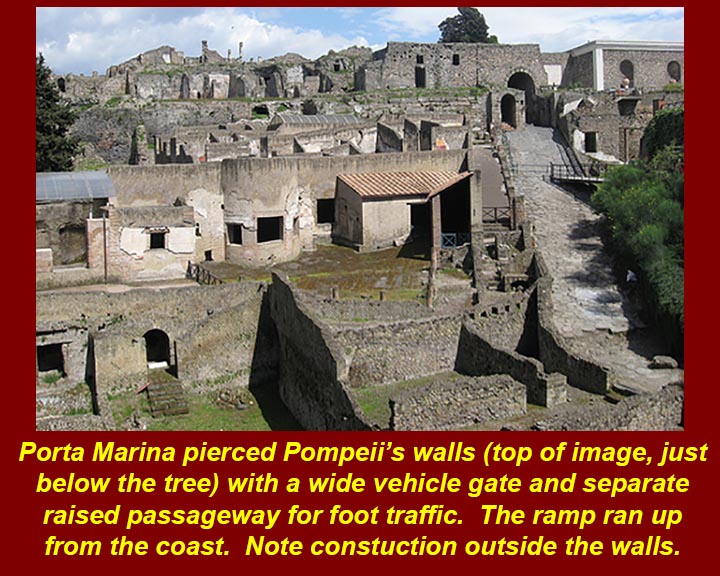
http://www.mmdtkw.org/ALRIVes0719yPortaMarina.jpg
Pompeii was built on a thirty meter thick lava tongue from a long previous eruption of Vesuvius. The ramp to the Porta Marina (water gate) led down to the river port near the mouth of the Sarno River just south of the cuty. The actual gate is near the top of the image under the lone tree at the very top. It had a wide wagon/cart entry way and a narrower raised pedestrian way to one side.
There is speculation that the building tunneled through by the gateway may have been a "customs/passport " shed. Buildings in the foreground below the city wall, which runs along the top of the image, are, literally, suburban.
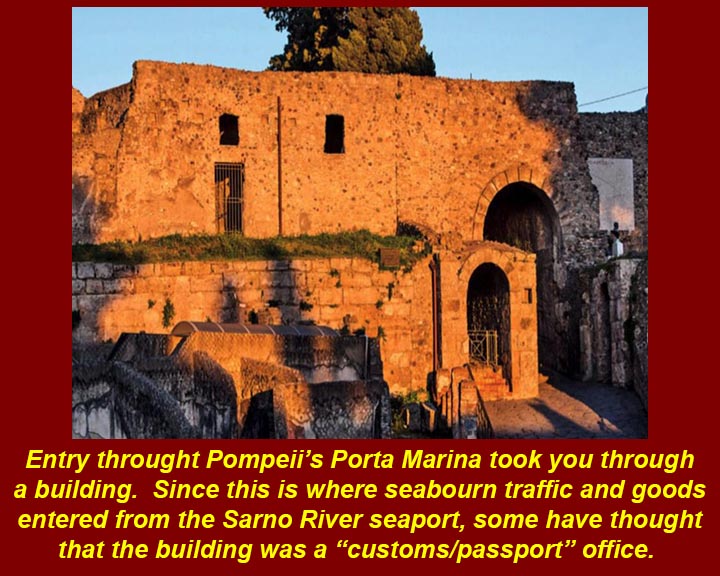
http://www.mmdtkw.org/ALRIVes0719zPortaMarina2.jpg
Porta Marina's actual entrances are at the top of the ramp that formerly descended from the city wall on top of the prehistoric lava tongue to the seacoast. What's now at at the bottom is what the archeological park calls Porta Marina Inferiora, the Ticket Kiosks and main entryway into the park
"Rustic" living
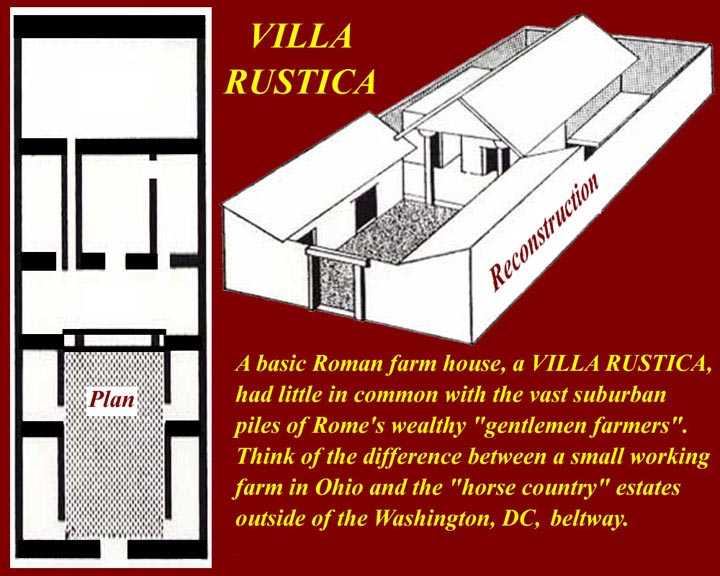
http://www.mmdtkw.org/ALRIVes0716VillaRustica.jpg
Anything outside the walls was "rustic". The basic farm house had accommodation for the owner (or overseer) and the animals and storage facility for tools and crops.
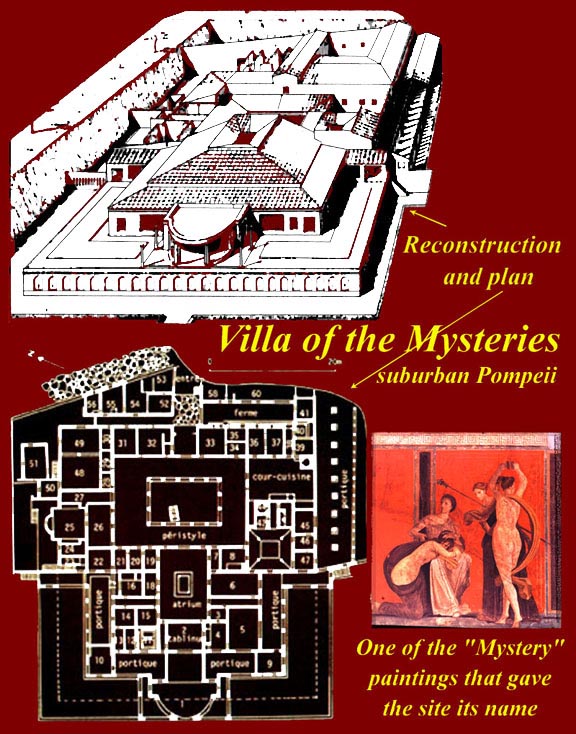
http://www.mmdtkw.org/ALRIVes0717VillaMystSlide.jpg
At the other end of the spectrum were huge establishments designed for "country living" by the rich. As fortunes grew and waned, some, like the Villa of the Mysteries, changed hands and added additional roles. By the time of the 79 AD eruption, this pile held large entertainment spaces for a rich middle-class owner and a winery that produced in commercial quantities.
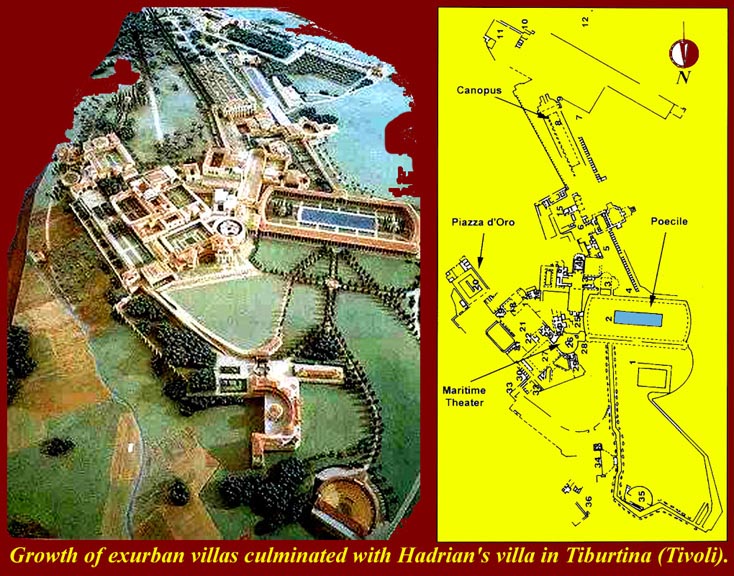
http://www.mmdtkw.org/ALRIVes0718HadrianVilla.jpg
The biggest "rustic villa" ever was the Villa Adriana in Tiburtina (now Tivoli) east of Rome. It was near therapeutic hot springs and also near the quaries that produced the "tiburtina" stone (travertine) that was used to build much of the villa and of Rome.
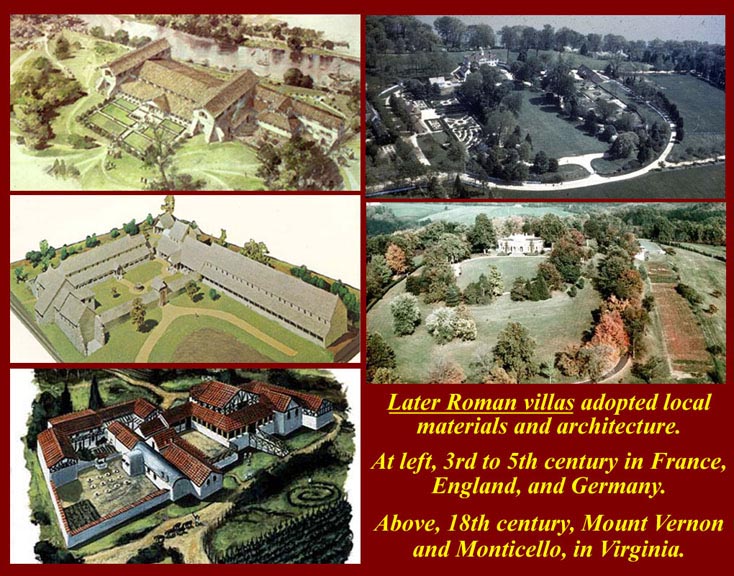
http://www.mmdtkw.org/ALRIVes0719LaterRomanVillas.jpg
The fashion of Roman villas didn't die with Rome.
Public buildings around the Pompeii forum.
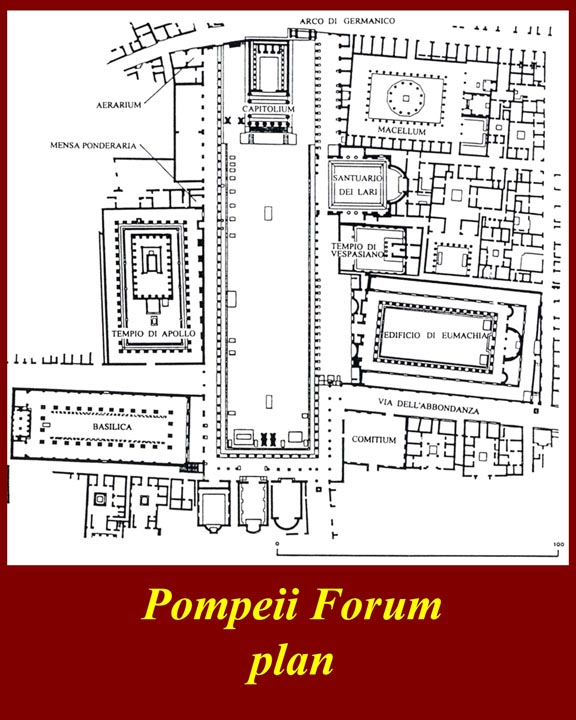
http://www.mmdtkw.org/ALRIVes0720ForumPlan.jpg
Map showing the major public buildings in the forum area.
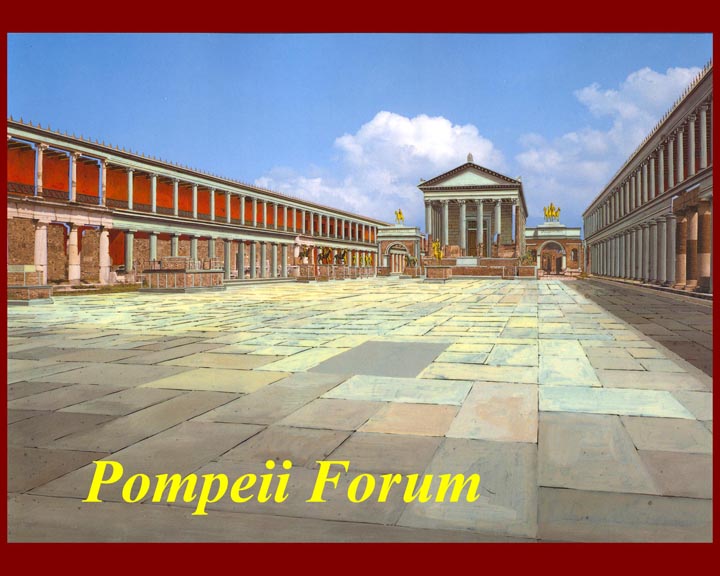
http://www.mmdtkw.org/ALRIVes0721ForumPompeii.jpg
Looking down the forum at the temple of the Capitoline Triad: Jupiter, Juno, and Minerva.
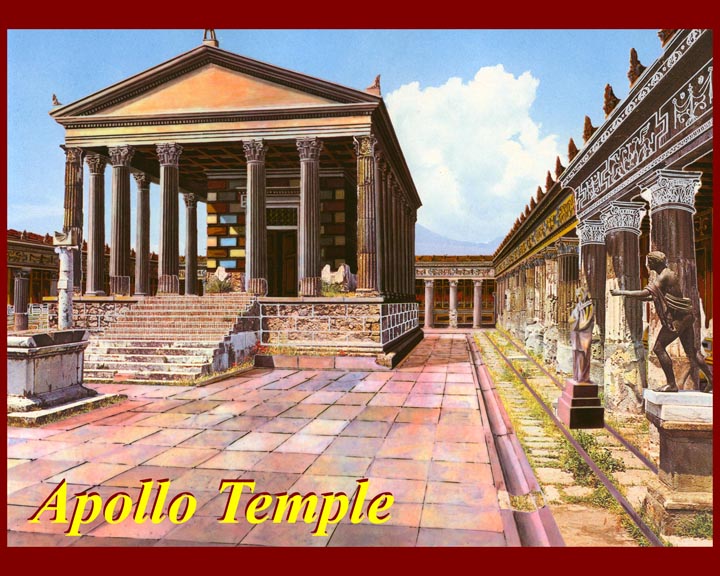
http://www.mmdtkw.org/ALRIVes0722ApolloTemple.jpg
The Apollo Temple at the side of the forum.
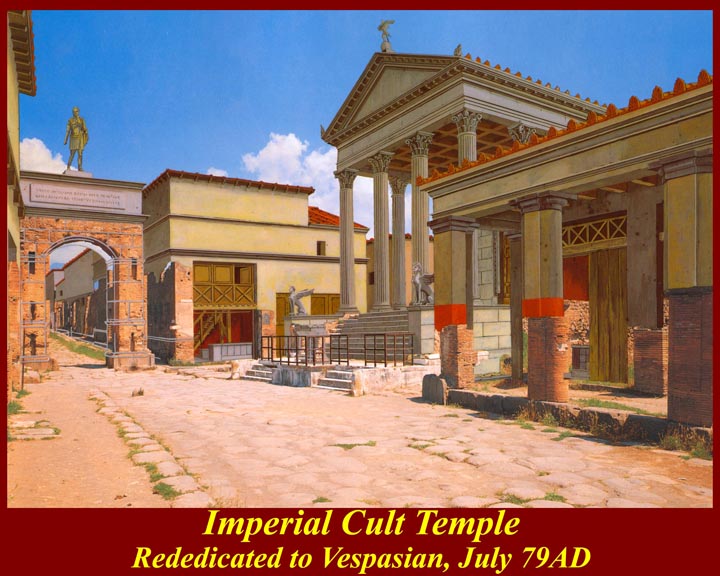
http://www.mmdtkw.org/ALRIVes0723ImperialCultTemple.jpg
The temple of the Imperial cult was rededicated to Vespasian by Titus, his son and successor, one month before the 79 AD eruption.
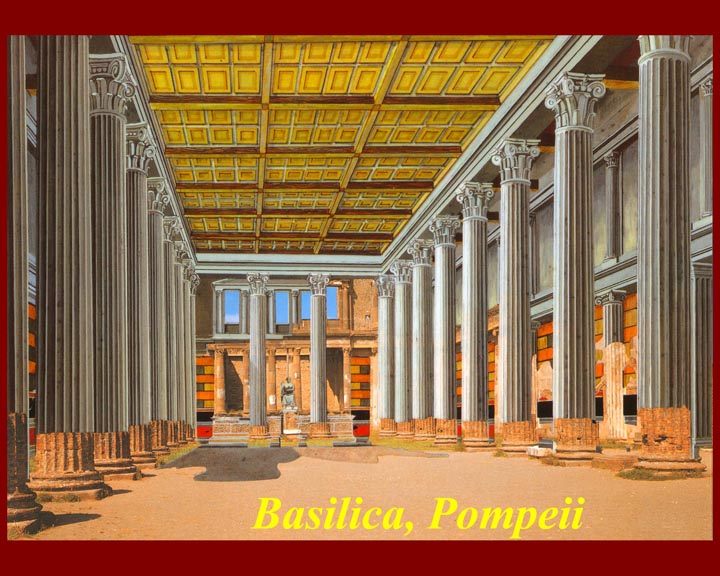
http://www.mmdtkw.org/ALRIVes0724BasilicaPompeii.jpg
The Basilica was the venue of courts and public functions.
Other public buildings
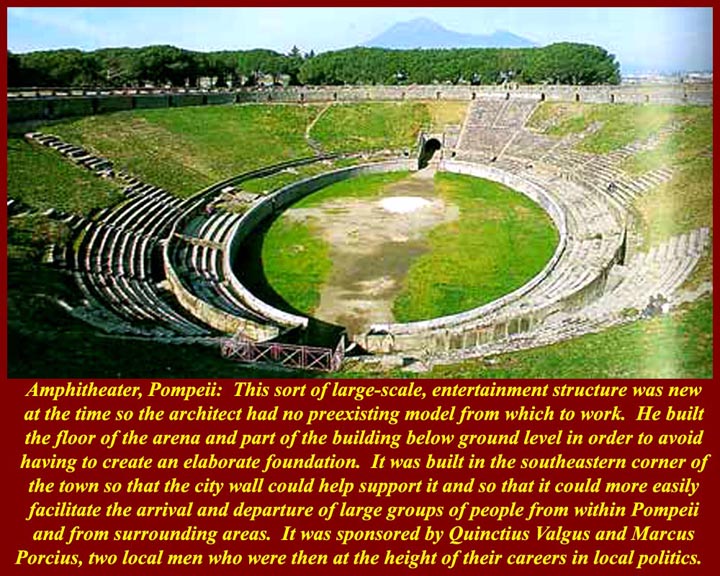
http://www.mmdtkw.org/ALRIVes0725AmphPompeii.jpg
The amphitheater was called a spectacula long before it was described as an "ambi-theater" or "theater on both sides". This one, built by Quinctius Valgus and Marcius Porcius at private expense, opened after 70 BC -- about 150 years before the big "Colossem" was built in Rome, and it is the earliest known stone amphitheater. It's not known if similar wooden structures existed earlier. This one held about 20,000 spectators (i.e., people who went to the spectacula). Before there were amphitheaters, gladiatorial contests were staged, first, in graveyards -- they were funerary games. Public games were first held in forums, still to commemorate fallen soldiers. When theaters started to be built, the games were moved there where they shared the bill with theatrical performances (which also started a funerary events.) Finally, amphitheaters supplanted theaters as gladiatorial venues.
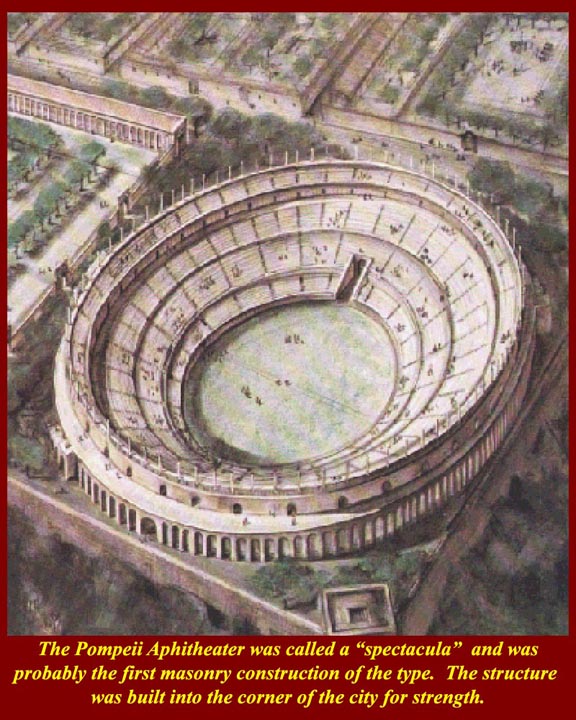
http://www.mmdtkw.org/ALRIVes0726PompeiiAmphitheater.jpg
Unlike the amphitheater in Rome, this one in Pompeii had no underground cages and passageways. The center of the arena (which in Latin meant "sand") was below ground level -- excavated and the dirt thrown up in an elliptical ridge to support the grandstands. (The theater, below, was built the same way.) Next to the amphitheater was a rectangular area for public participation sports -- only a corner is visible at the upper left of this picture.
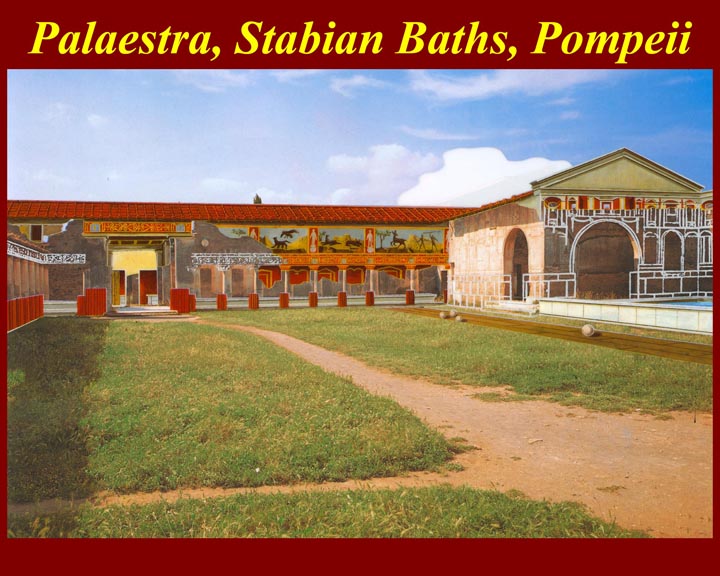
http://www.mmdtkw.org/ALRIVes0727PalaestraStabianBaths.jpg
Another venue for public participation sports was this palaestra at the Stabian baths (the baths just inside the Stabian Gate of Pompeii.
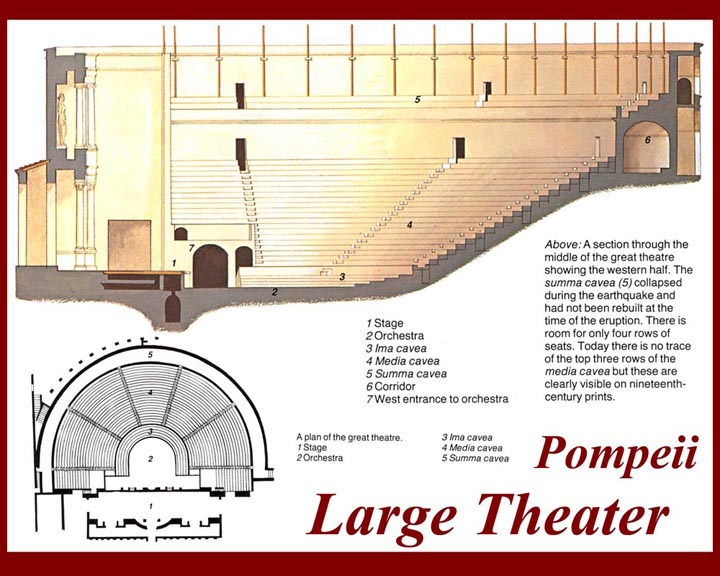
http://www.mmdtkw.org/ALRIVes0728Theater.jpg
The theater had a slightly deeper orchestra than was usual in Roman theaters. It was free standing (unlike hillside "Greek" theaters, but the orchestra was below grade level.
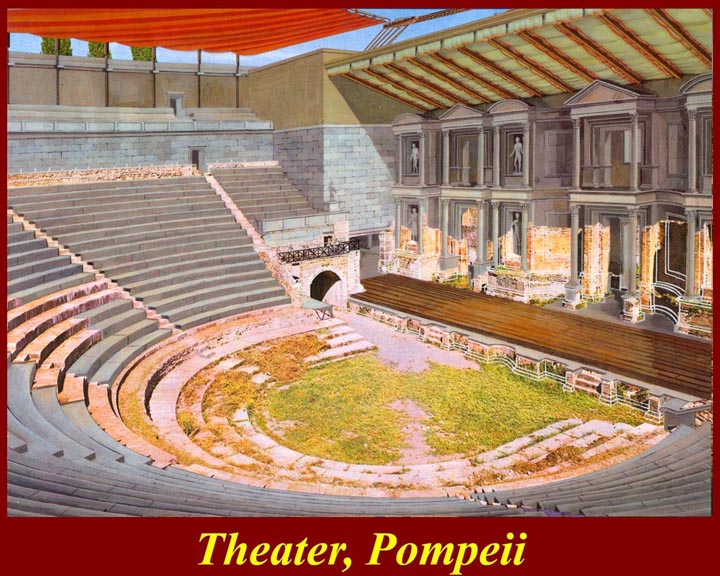
http://www.mmdtkw.org/ALRIVes0729TheaterPompeii.jpg
A view of what was: awnings protected the audience (from audientia = a hearing). Adjoining the theater was a smaller odeon, a roofed structure for musical performances and poetry "readings".
Odes, actually, were almost always sung by their author/composers and were self-accompanied on the cithara (a lyre-like instrument). Nero was singing one of his odes in the Pompeii odeon when the 64 AD earthquake struck. The odeon did not fall down, and Nero said it was because the god (Apollo) was pleased with the imperial performance.
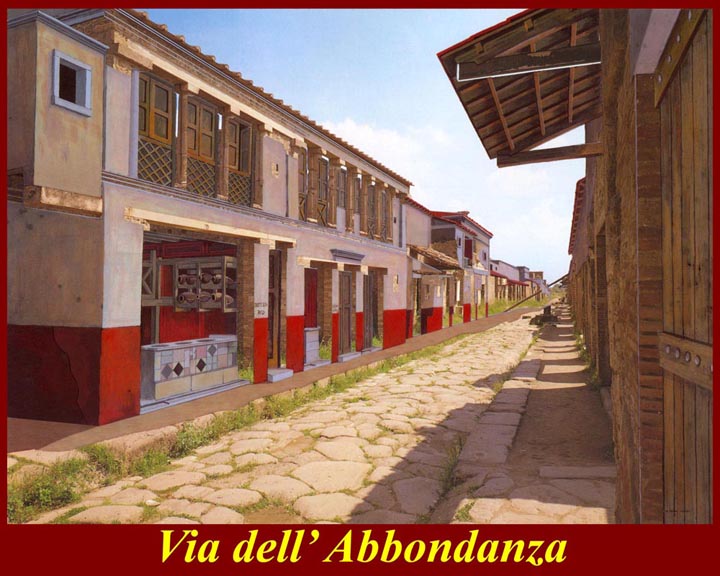
http://www.mmdtkw.org/ALRIVes0730ViaAbbondanza.jpg
The Via Abbondanza ran out from one corner of the forum and appears to have been the main shopping district.
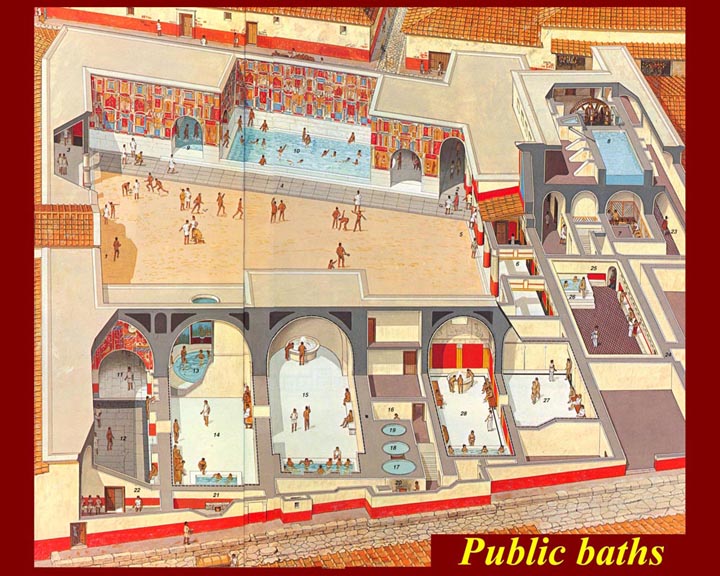
http://www.mmdtkw.org/ALRIVes0731PublicBaths.jpg
The Stabian baths had the standard chambers and functions, but no separate facilities for women. Among its rooms were several small cubicula whose unknown function has caused centuries of gossip. There were four sets of public baths, but the "central baths" were still under construction at the time of the eruption. The central baths, the forum baths, and the Stabian baths can be visited, but the fourth set was reburied.
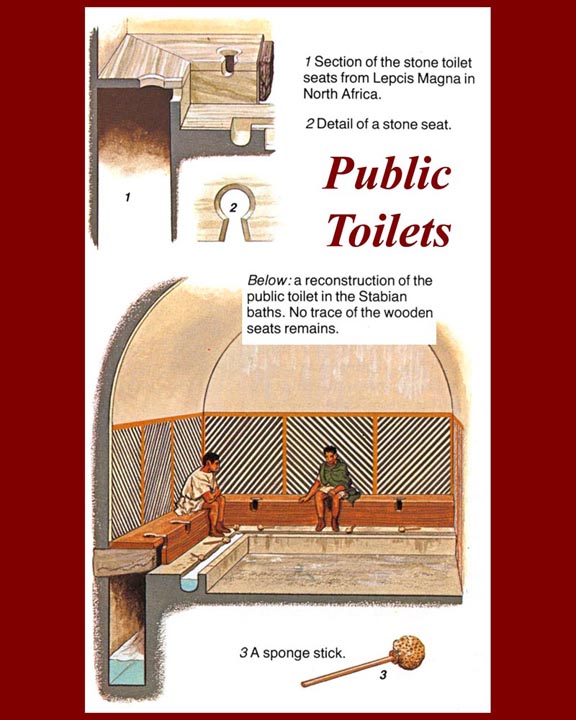
http://www.mmdtkw.org/ALRIVes0732PublicToilets.jpg
Public toilets were spotted around the city, some privately funded and some built at public expense. This large establishment was at a corner of the forum. Urine was collected in pots on street corners and in front of fulleries for use in processing and cleaning cloth.
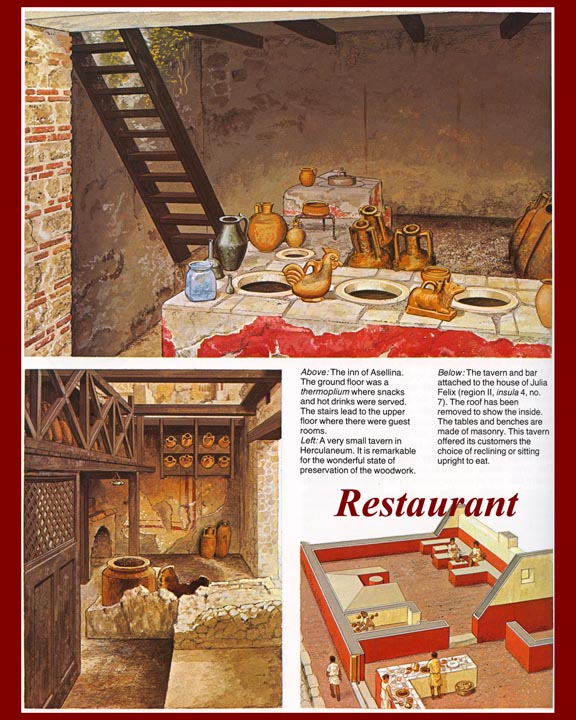
http://www.mmdtkw.org/ALRIVes0733Restaurant.jpg
A small snack bar with an upstairs room which was probably an apartment or storeroom. Some establishments had back rooms or upstairs dining rooms and some, inevitably, had rooms where sex was available for money. The masonry counter fronted on the street and held embedded pottery jugs for hot or cold food.
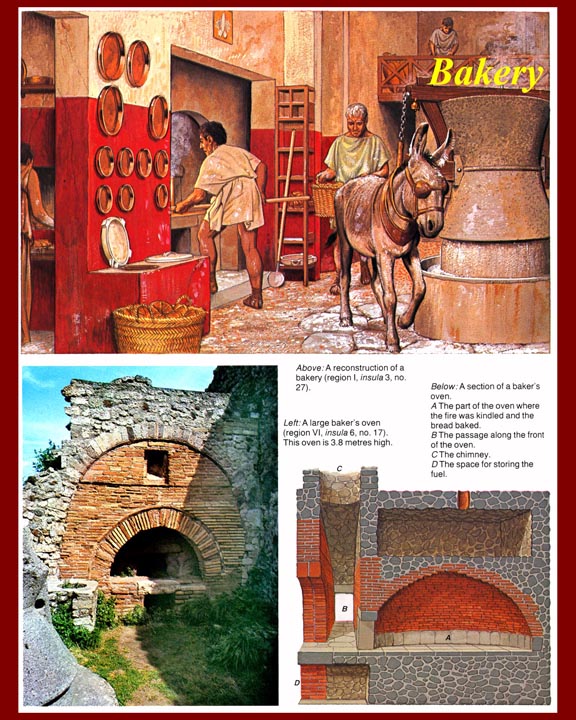
http://www.mmdtkw.org/ALRIVes0734Bakery.jpg
A combination mill and bakery. Grain was distributed daily to anyone who cared to go to the distribution points. The grain was taken to the the bakery where it could be exchanged immediately for bread, at a slight premium. Bread was made in several grades: the rich ate white bread and the poor ate whole grain. All grain was "stone-ground", so grit found its way into the flour and baked goods -- causing characteristic tooth wear. Pompeii, with large quarries of volcanic stone appropriate for making millstones, provided grinding equipment to millers throughout central Italy.
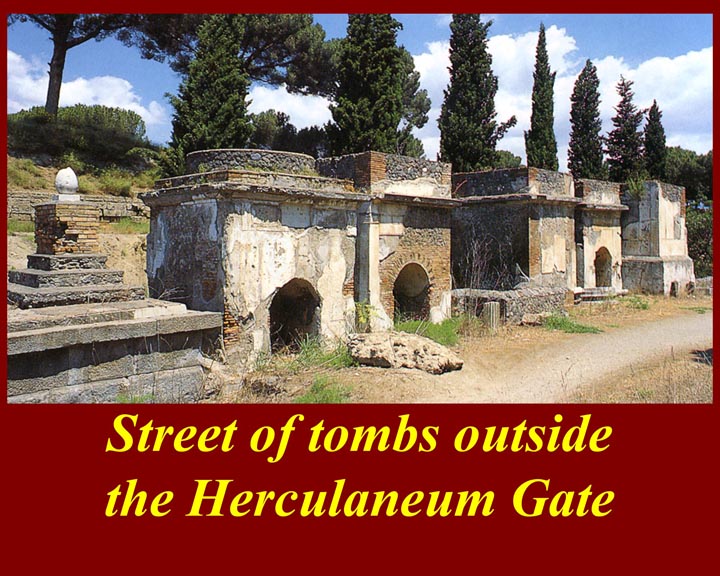
http://www.mmdtkw.org/ALRIVes0735TombStreet.jpg
Tombs were always outside the pomerium, or sacred municipal precinct, which, in practice, meant outside the walls of a city: the pomerium expanded with the city walls.
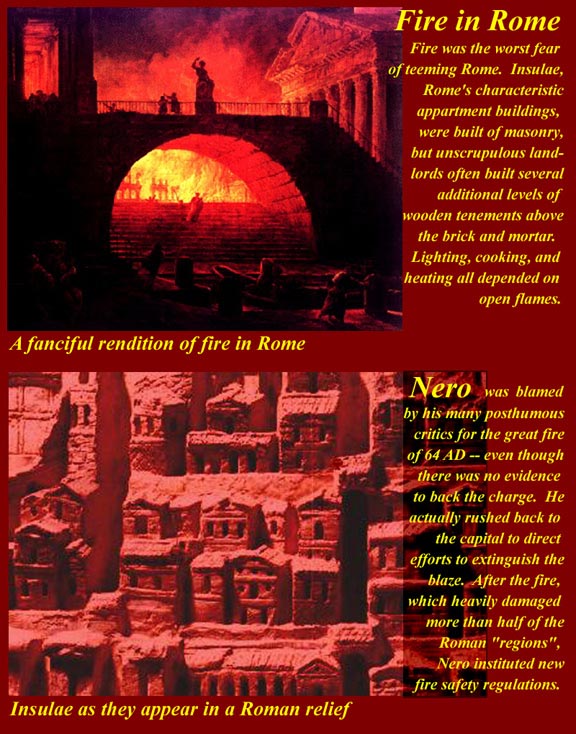
http://www.mmdtkw.org/ALRIVes0736RomeFireInsulae.jpg
Publicly funded fire brigades were organized by Nero in all Roman cities after Rome burned in 64 AD. There had been some fire regulations in Rome and Ostia at least from the time of Augustus.
Art and Decoration
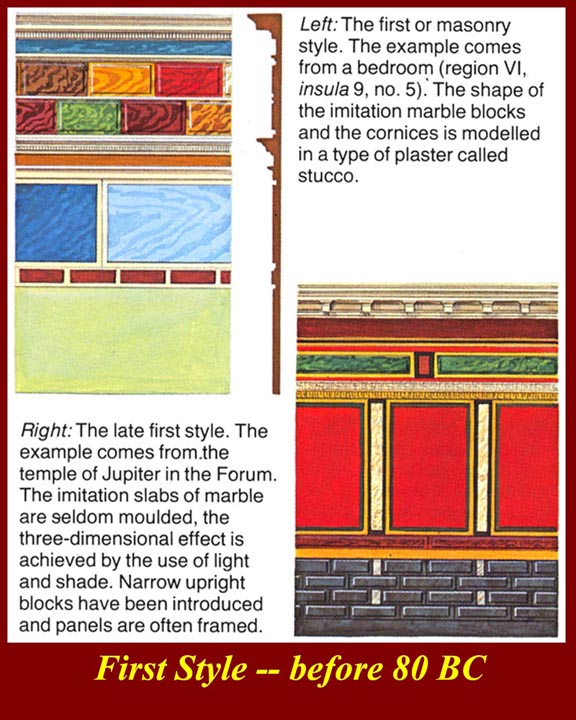
http://www.mmdtkw.org/ALRIVes0737FirstStyle.jpg
Romans used frescoes, mosaics, and sculpture as decoration, although some works approach what we call "art", most was not very good. Much of their art was derivative of Greek art. Naturally, the museums only stock the best, giving the impression that "Roman art" was heavy on masterpieces.
Pompeian wall decorations were usually frescoes (mosaics were usually on the floor.) August Mau's 19th century "four styles" are still used to describe Pompeian frescoes. From the beginning, large areas of stylistic overlap have been recognised, but only recently have chronological overlaps been added into the mix. It's now apparent that the four styles were additive and that new versions of old styles were sometimes done to add variety.
The first style was an imitation of marble panels. First the panels would be molded and in various levels. Later examples add "pillars" and the panels were not molded, but rather they were painted on flat surfaces with the illusion of depth accomplished by painted-on shadows.
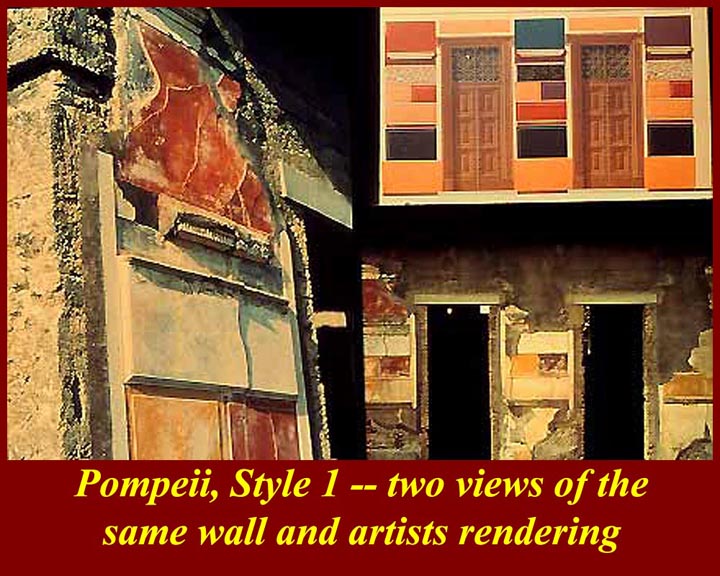
http://www.mmdtkw.org/ALRIVes0738PompeiiStyle1Salust.jpg
Style 1
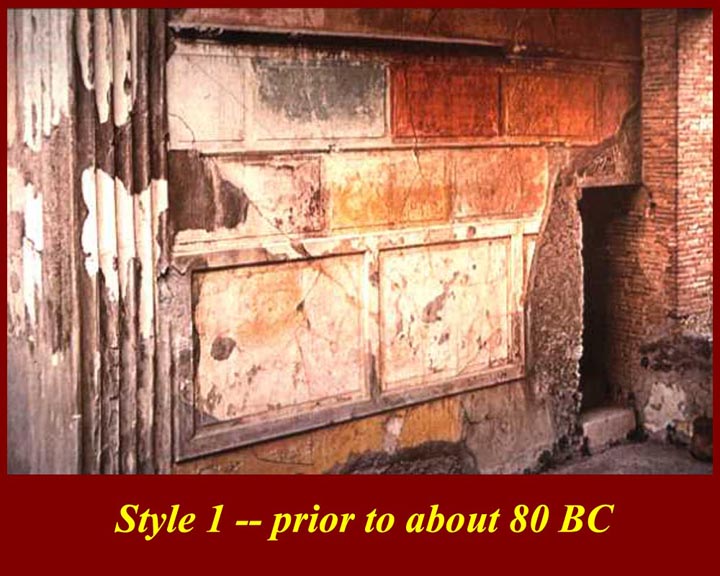
http://www.mmdtkw.org/ALRIVes0739PompeiiStyle1aSallust.jpg
Style 1
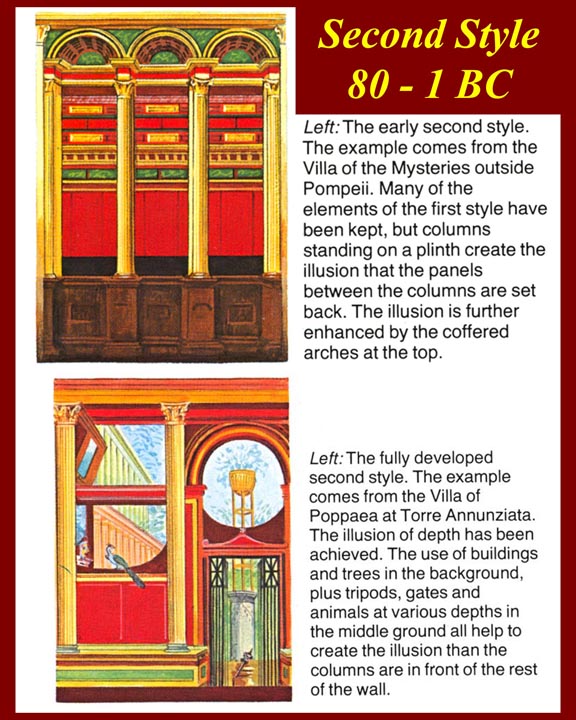
http://www.mmdtkw.org/ALRIVes0740SecondStyle.jpg
Early style 2 added some architectural detail to the pillars and later style 2 added "openings", into which the "outside world" was painted.
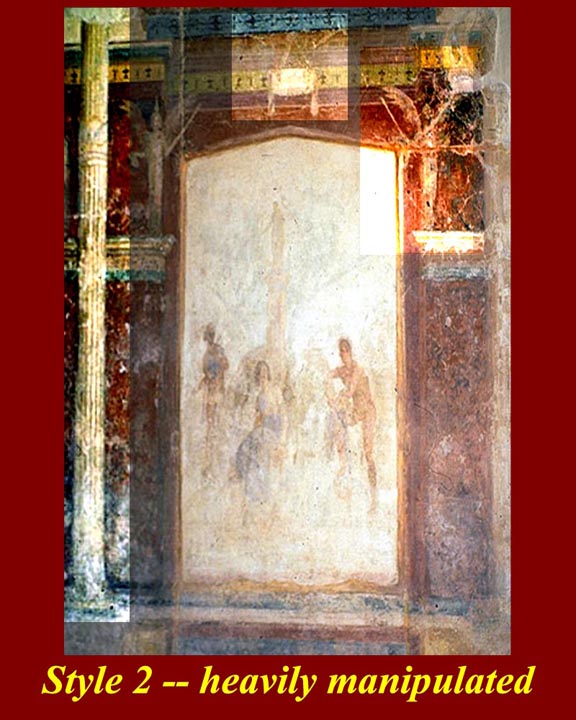
http://www.mmdtkw.org/ALRIVes0741PompeiiStyle2Manipulated.jpg
Painted "outside world" scenes could be architectural, rustic, or mythological, with the latter appearing most often in upper class homes.
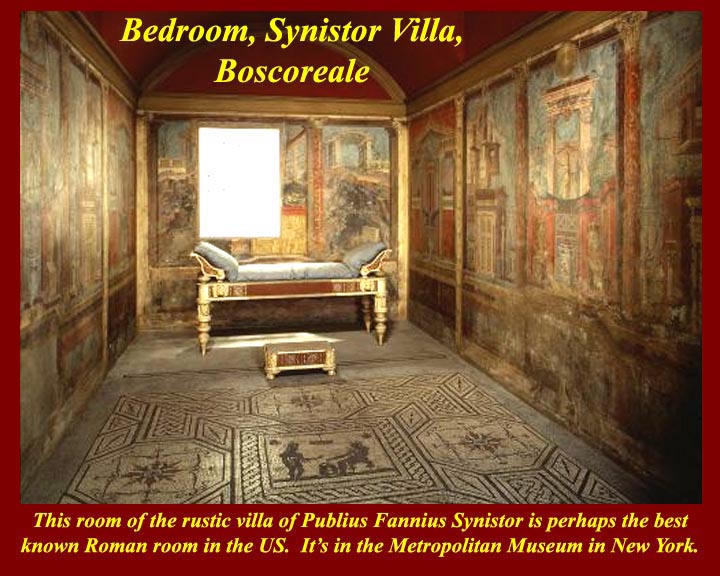
http://www.mmdtkw.org/ALRIVes0742PompeiiStyle2Synistor1.jpg
This style 2 room from the Villa Synistor which was excavated in Boscoreal is now in the Metropolitan Museum in New York. Other parts of the Villa were exported (1902) by the landowner, on whose estate the Villa was found, to the Louvre and other museums. It turned out that this was a lucky circumstance, as the excavated Villa was backfilled and the site was then partially buried by a lava flow from Vesuvius in 1906.
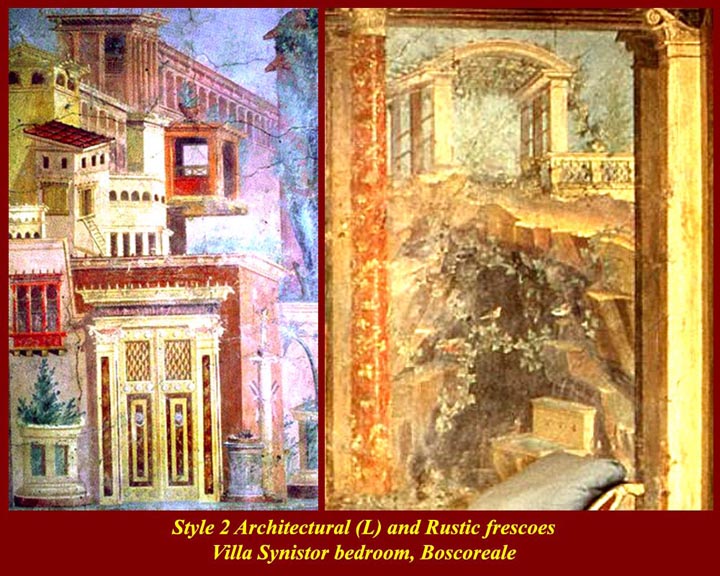
http://www.mmdtkw.org/ALRIVes0743PompeiiStyle2Synistor2.jpg
Style 2 scenes from the Villa Synistor room in the Met. The "rustic" scene on the right is characteristic of that style -- "rustic" in this context implies the "rusticity" of a rich suburban villa. The "architectural" scene on the left is much more complex than most of its kind, and the interlocking perspectives make it look like something designed by MC Escher.
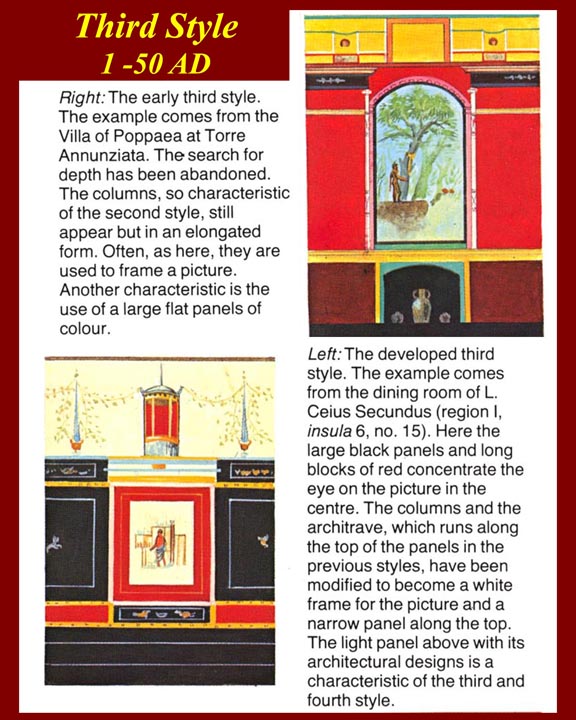
http://www.mmdtkw.org/ALRIVes0744ThirdStyle.jpg
Style 3 added large flat panels of color and the scenes gradually shrunk to smaller sizes: they were no longer "openings' but now were more like framed paintings.
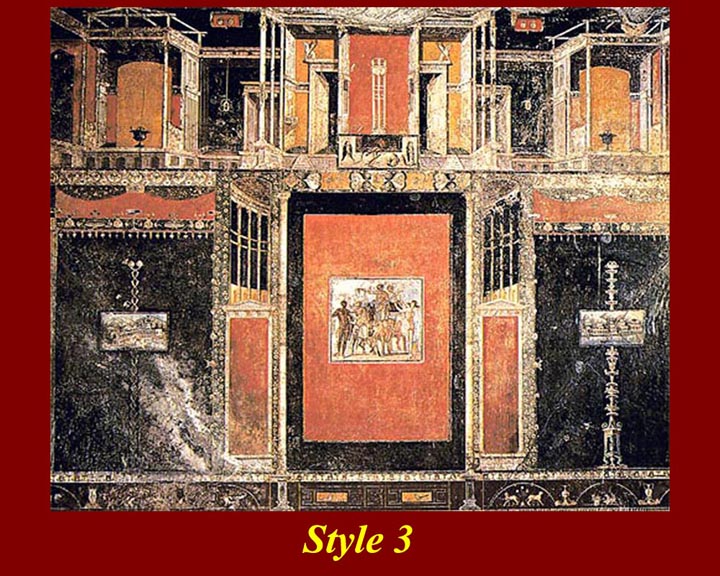
http://www.mmdtkw.org/ALRIVes0745PompeiiStyle3a.jpg
Style 3 architectural details became more attenuated and stylized.
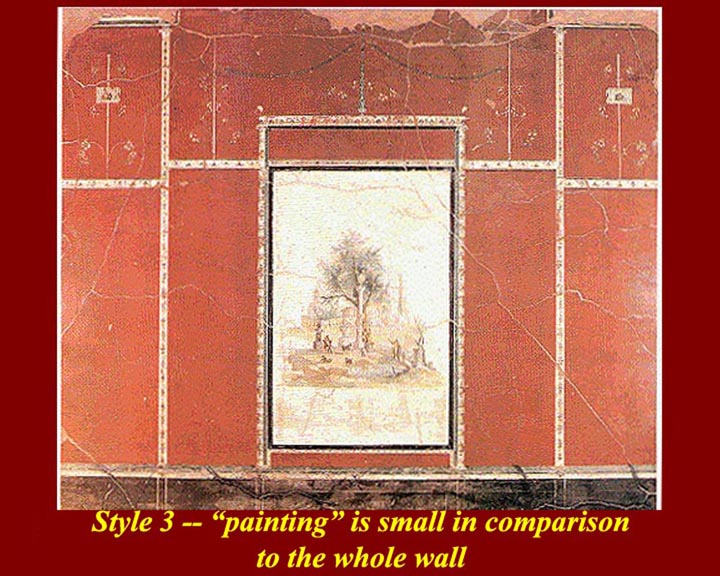
http://www.mmdtkw.org/ALRIVes0746PompeiiStyle3b.jpg
Style 3
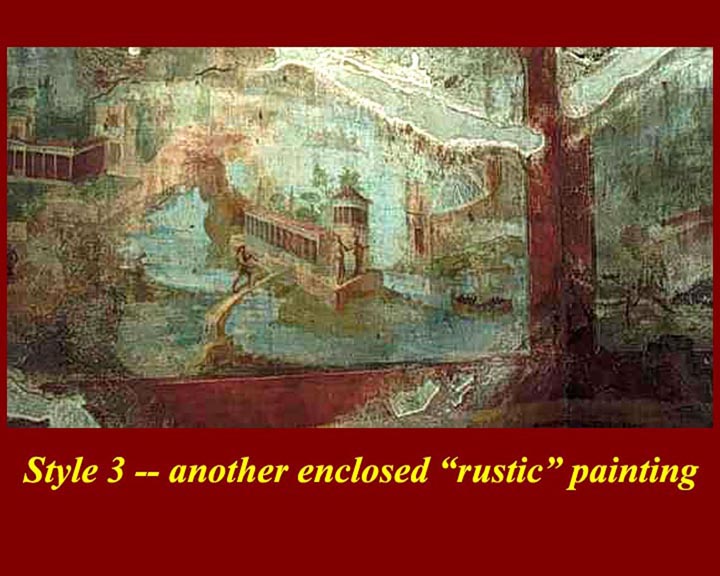
http://www.mmdtkw.org/ALRIVes0747PompeiiStyle3FontPiccola.jpg
Although style three scenes became smaller, they were still quite detailed.
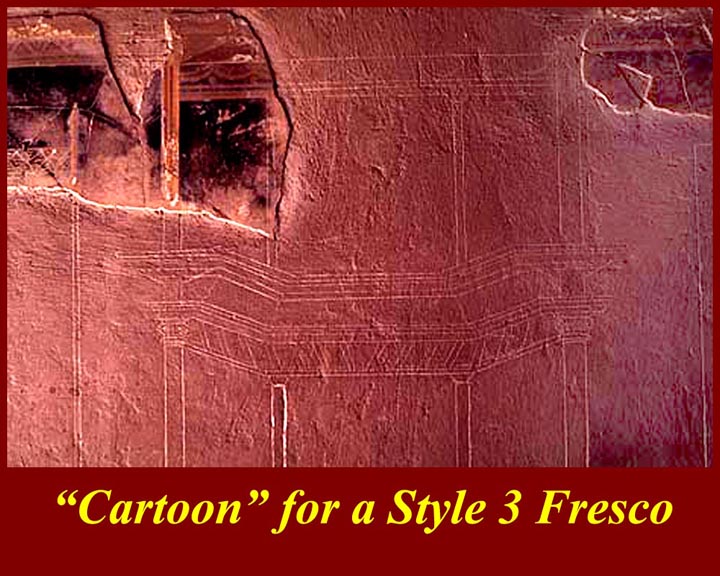
http://www.mmdtkw.org/ALRIVes0748PompeiiStyle3FrescoCartoon.jpg
Painters applied fresh plaster in small sections to walls, on which the outlines of the composition were already incised. Here the surface layer has fallen off exposing the "cartoon."
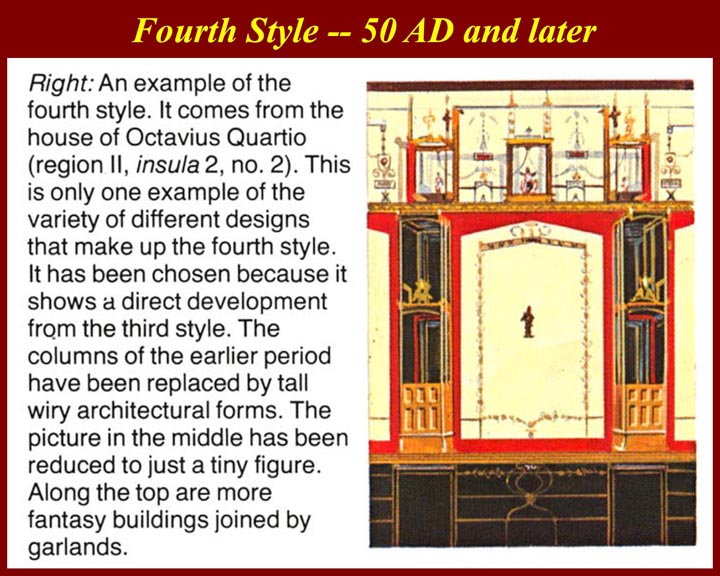
http://www.mmdtkw.org/ALRIVes0749FourthStyle.jpg
Fourth style was composite and eclectic and carried forward earlier trends. "Scenes" became individual and sometimes tiny, architectural details still more tenuous and fantastic. There was a great deal of variation.
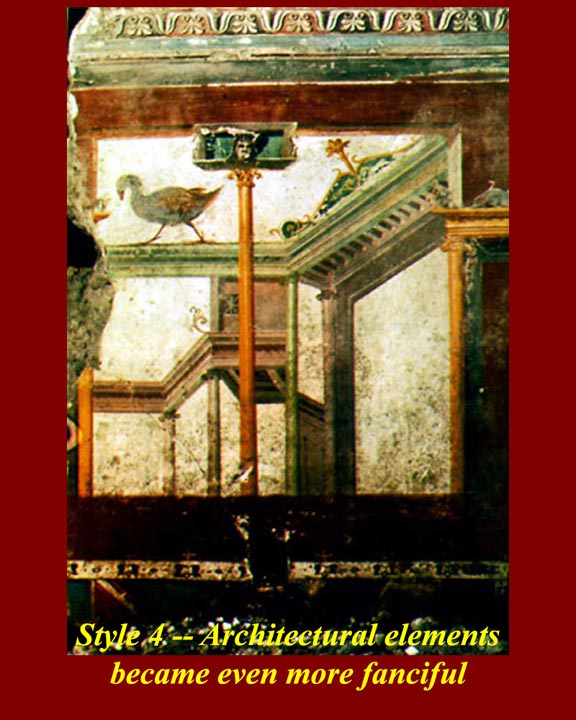
http://www.mmdtkw.org/ALRIVes0750PompeiiStyle4.jpg
By the time of the eruption, Style 4 was almost surreal.
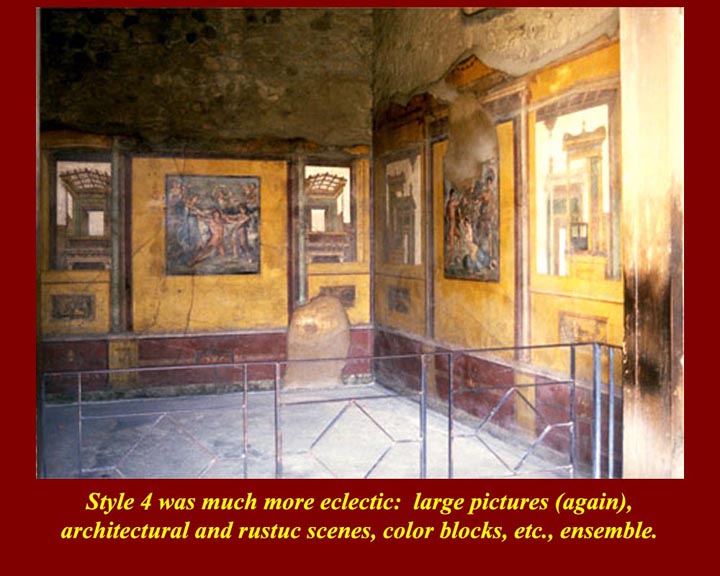
http://www.mmdtkw.org/ALRIVes0751PompeiiStyle4Vettii.jpg
The house of the Vetti in Pompeii was being redecorated in Style 4 at the time of the eruption. This particular example of style 4 has the look of a picture gallery, but everything is fresco painted onto the walls. It's thought that the Renaissance "quadratura" (= "framed") fresco style was in imitation of this style.
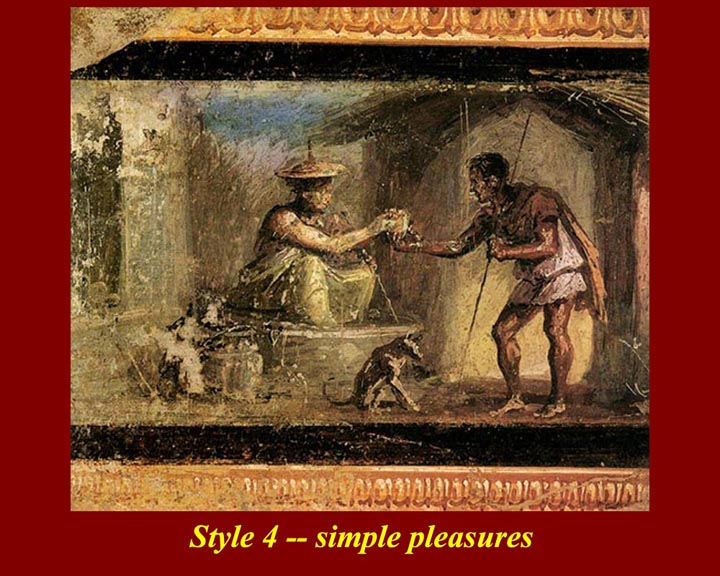
http://www.mmdtkw.org/ALRIVes0752PompeiiStyle4Traveler.jpg
A tiny style 4 scene.
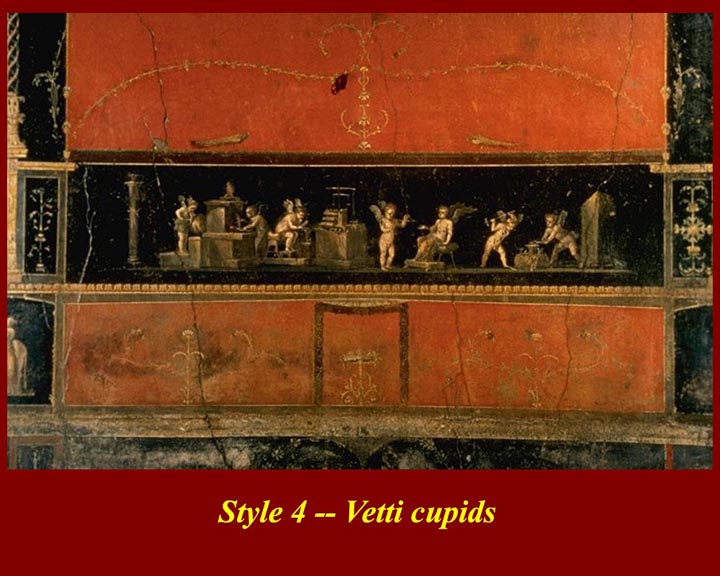
http://www.mmdtkw.org/ALRIVes0753PompeiiVettiCupids1.jpg
Occupational information: Vetti House "Golden Cupids" have given a great deal of information on how things were done.
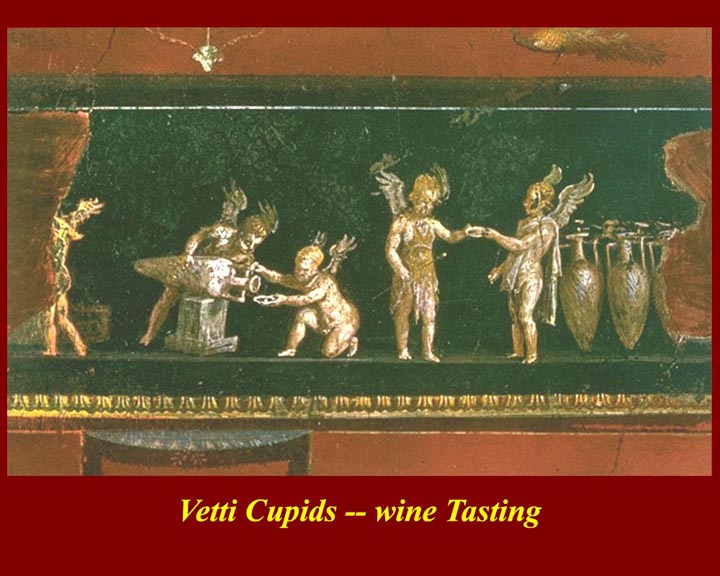
http://www.mmdtkw.org/ALRIVes0754PompeiiVettiCupidsTasting.jpg
More Vetti Cupids
Other artwork
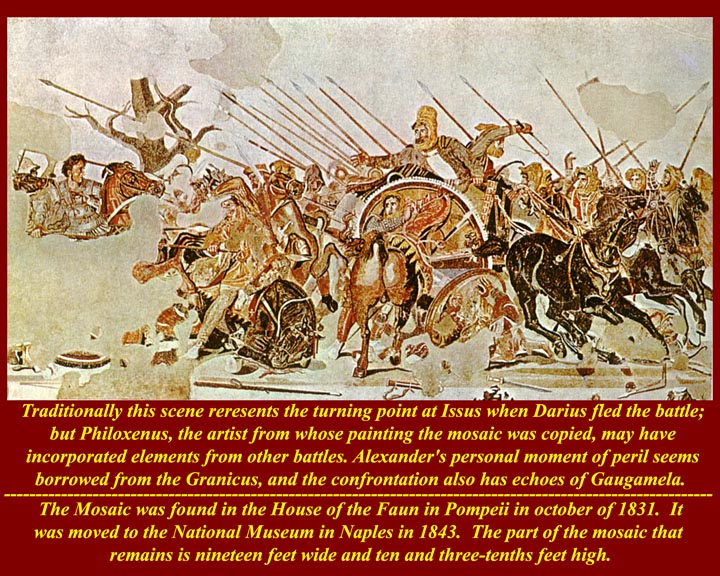
http://www.mmdtkw.org/ALRIVes0755AlexMos.jpg
The Alexander mosaic (ca. 100 BC), from a floor in the House of the Faun in Pompeii, shows the Battle of Issus where Alexander defeated the Persian King, Darius III. From the composition and findspot it appears that about two-thirds of the mosaic is preserved (now in the National Archeological Museum in Naples). The mosaic was famous in its own time and was identified by Pliny the Elder as a copy of a Greek painting by "Piloxenus" of Eretria, created for King Cassander of Macedonia. The mosaic (the 2/3 of the original that was preserved -- about 16 feet or 5 meters wide) was moved to the National Museum in Naples in 1843, and a full scale copy was installed in the mosaic's original location in the House of the Faun at the end of 2005. (For more information, see (http://www.archaeology.org/0601/abstracts/mosaic.html).
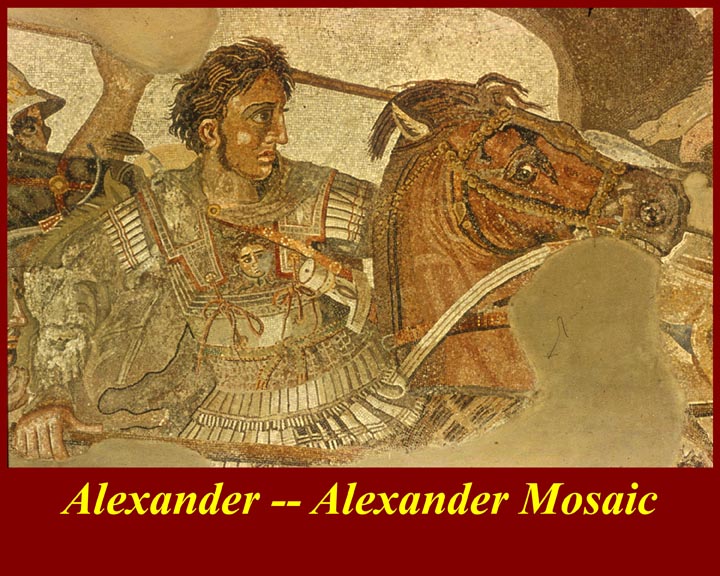
http://www.mmdtkw.org/ALRIVes0756Alexander.jpg
Alexander
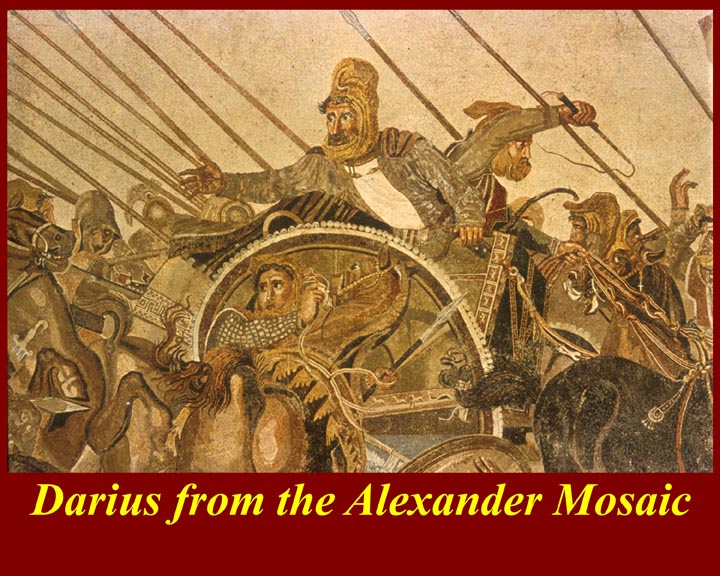
http://www.mmdtkw.org/ALRIVes0757DariusAlexMosaic.jpg
Darius
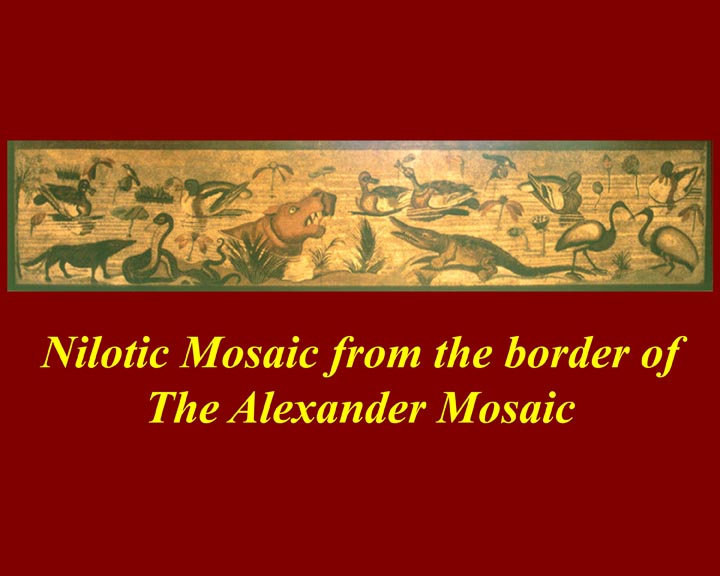
http://www.mmdtkw.org/ALRIVes0758NiloticAlexanderBorder.jpg
The border below the Alexander Mosaic was this Nilotic scene. It has nothing to do with the Alexander scene and was probably installed simply to fill the extra floor space.
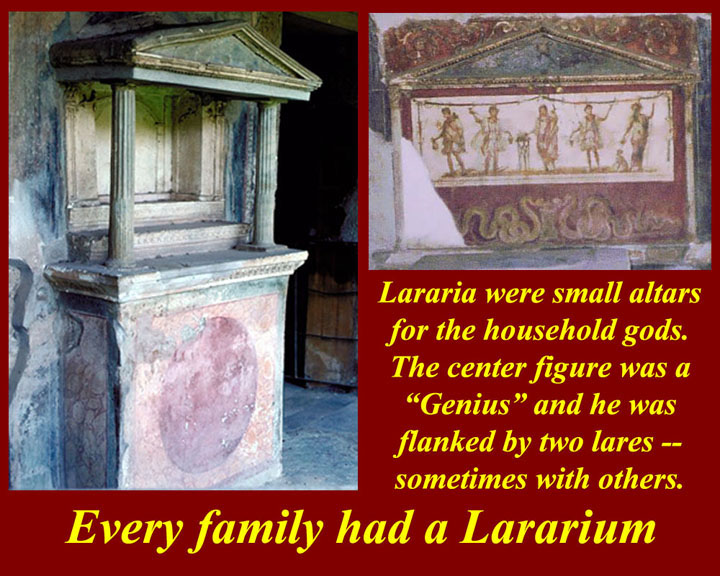
http://www.mmdtkw.org/ALRIVes0759Lararium.jpg
Every house had a Lararium or family shrine. The Lares (singular, Lar) almost always appeared as a pair of young men holding aloft wine goblets. They flanked the genius or spirit of the family. A snake or a pair of snakes almost always were included, as a good luck icon (conjecture: rat catchers?)
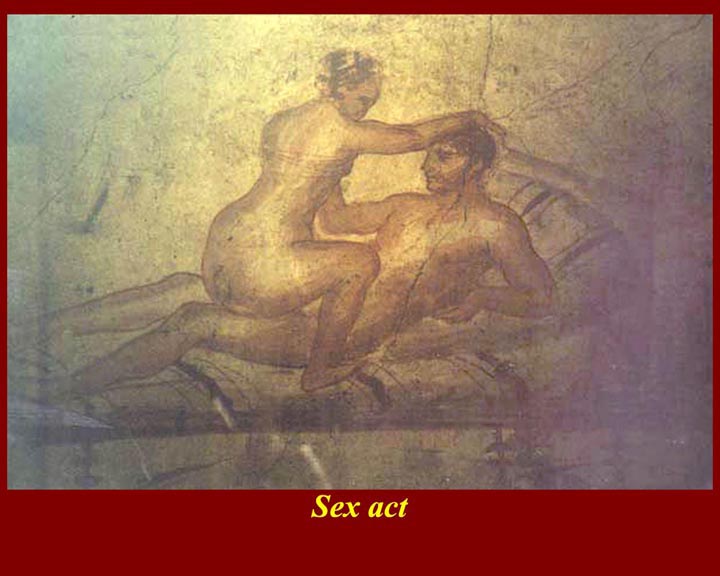
http://www.mmdtkw.org/ALRIVes0760Couple.jpg
Another form of popular "art" was what we would have called pornography -- it was intended to be prurient. It appeared in bars, restaurants, baths and other "public houses", but also in the houses of the rich. Nobody likes to say it -- it's not politically correct -- but the taste for pornography might well have stemmed from the fact that Pompeii was resettled as a military colony (Colonia Veneria) after General Sulla conquered the city in 89 BC, and the Oscan upper classes had been displaced by demobilized soldiers.
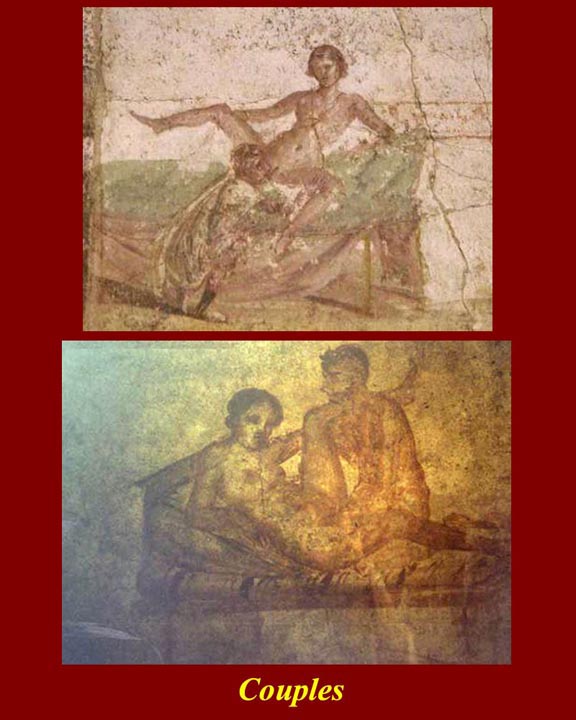
http://www.mmdtkw.org/ALRIVes0761Couples.jpg
More Venerial art -- scenes from above the cells of a brothel which may have been advertizements for what was available in each room
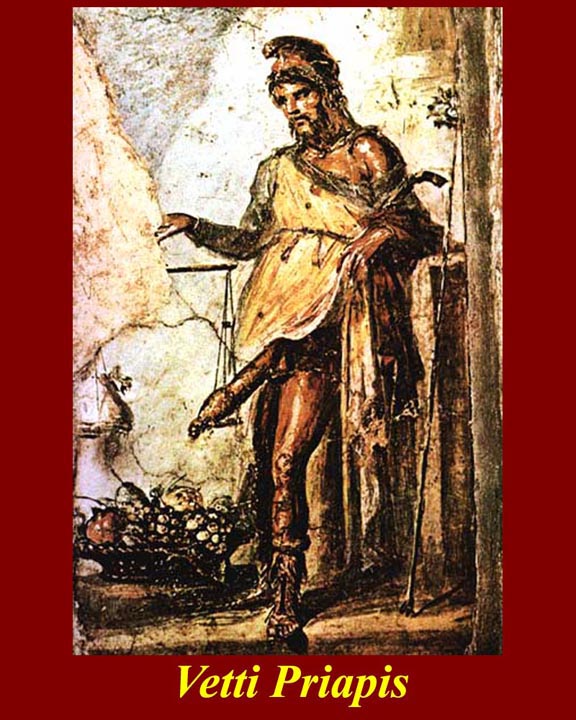
http://www.mmdtkw.org/ALRIVes0762VettiPriapis.jpg
At the front door of the Vetti House, Priapus weighs himself against wealth.
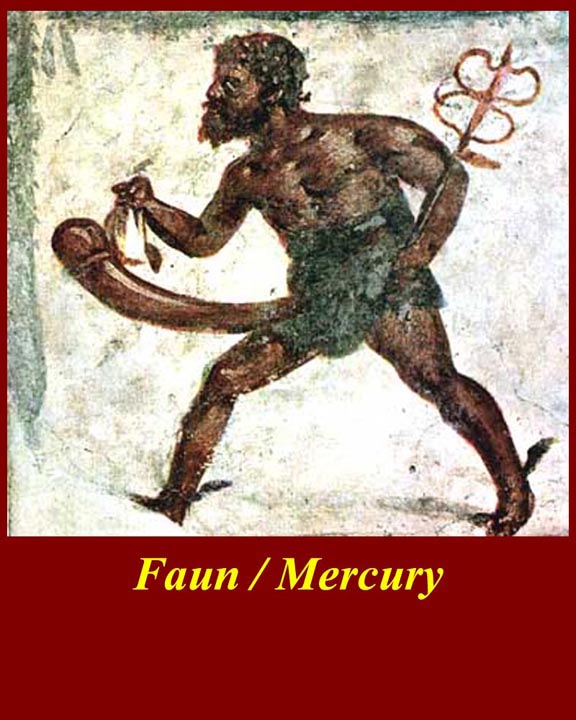
http://www.mmdtkw.org/ALRIVes0763FaunMercury.jpg
"Mercury" delivering a message.
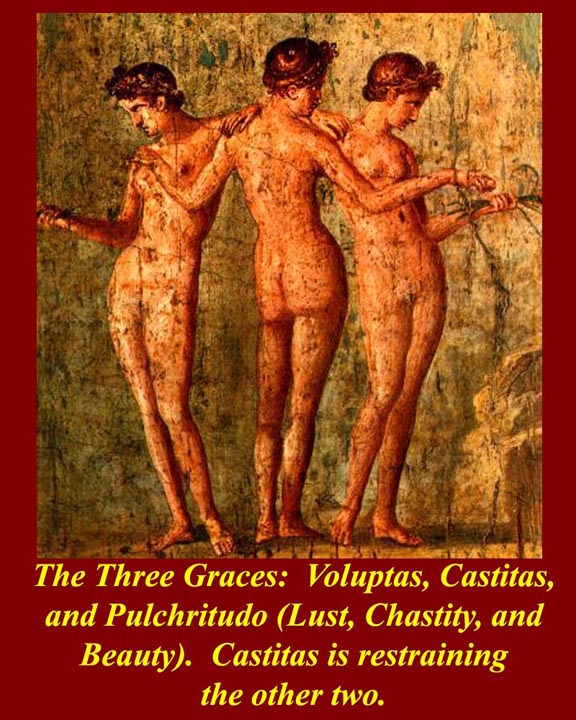
http://www.mmdtkw.org/ALRIVes07643GracesPompeii.jpg
The "Three Graces" Chastity tries to restrain Lust and Beauty. The motif was very common and remained so through the centuries.
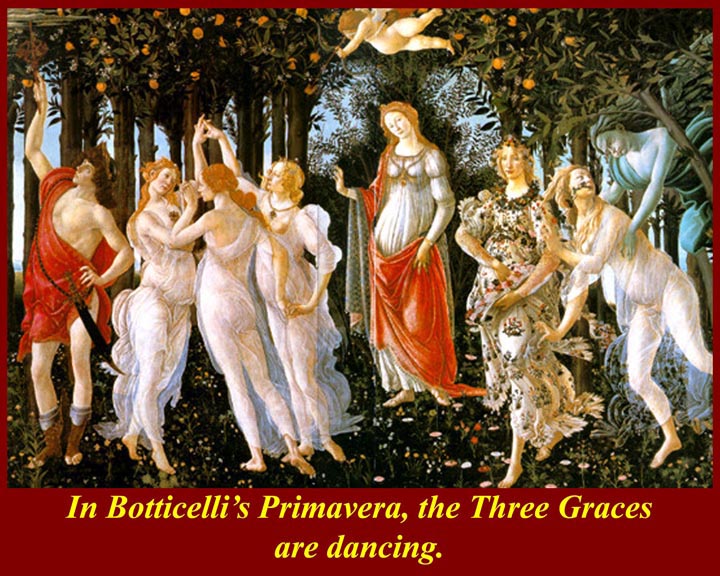
http://www.mmdtkw.org/ALRIVes07653GracesBotticelli.jpg
By the Renaissance the Three Graces are dancing (Botticelli) ...
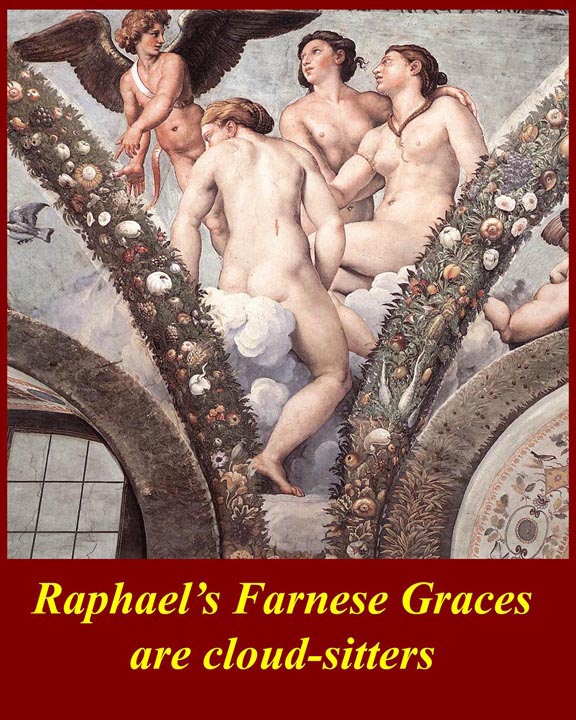
http://www.mmdtkw.org/ALRIVes07663GracesRaphael.jpg
or sitting on clouds (Raphael).
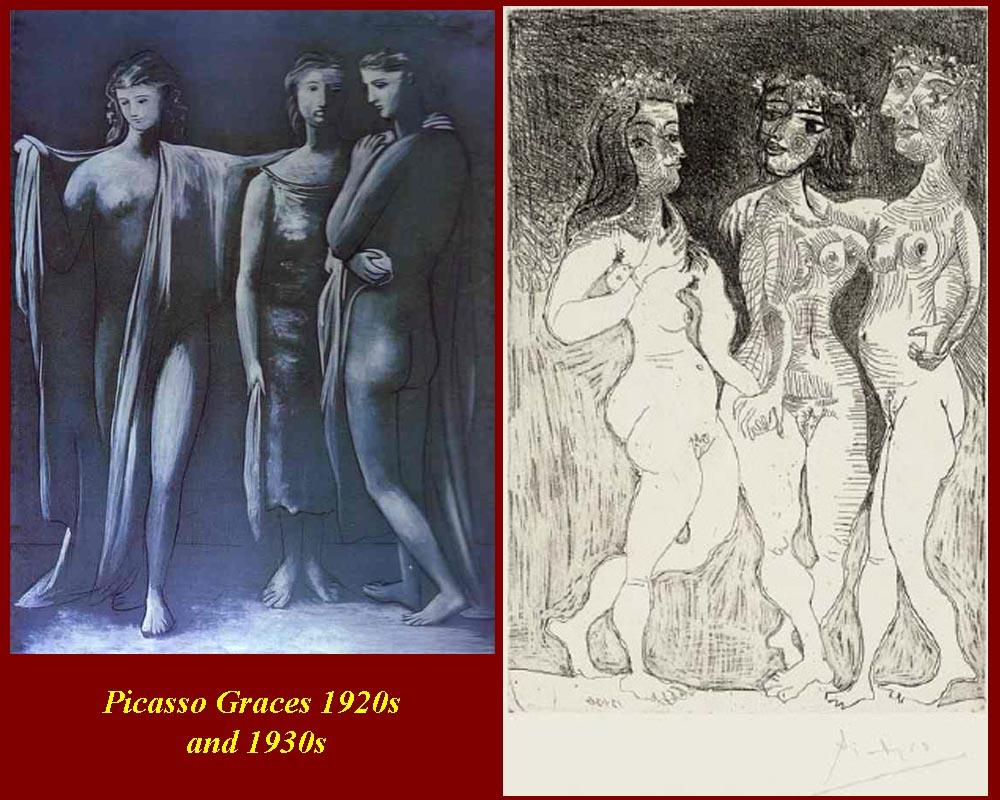
http://www.mmdtkw.org/ALRIVes07673GracesPicasso.jpg